Table of Contents
- 1 Getting to know your wireless router
- 2 Getting started
- 3 Quick Look your Wireless Router
- 4 Configuring the Advanced Settings
- 5 Utilities
- 6 Troubleshooting
- Appendices
ASUS 4G-AC55U User Manual
Displayed below is the user manual for 4G-AC55U by ASUS which is a product in the Wireless Routers category. This manual has pages.
Related Manuals
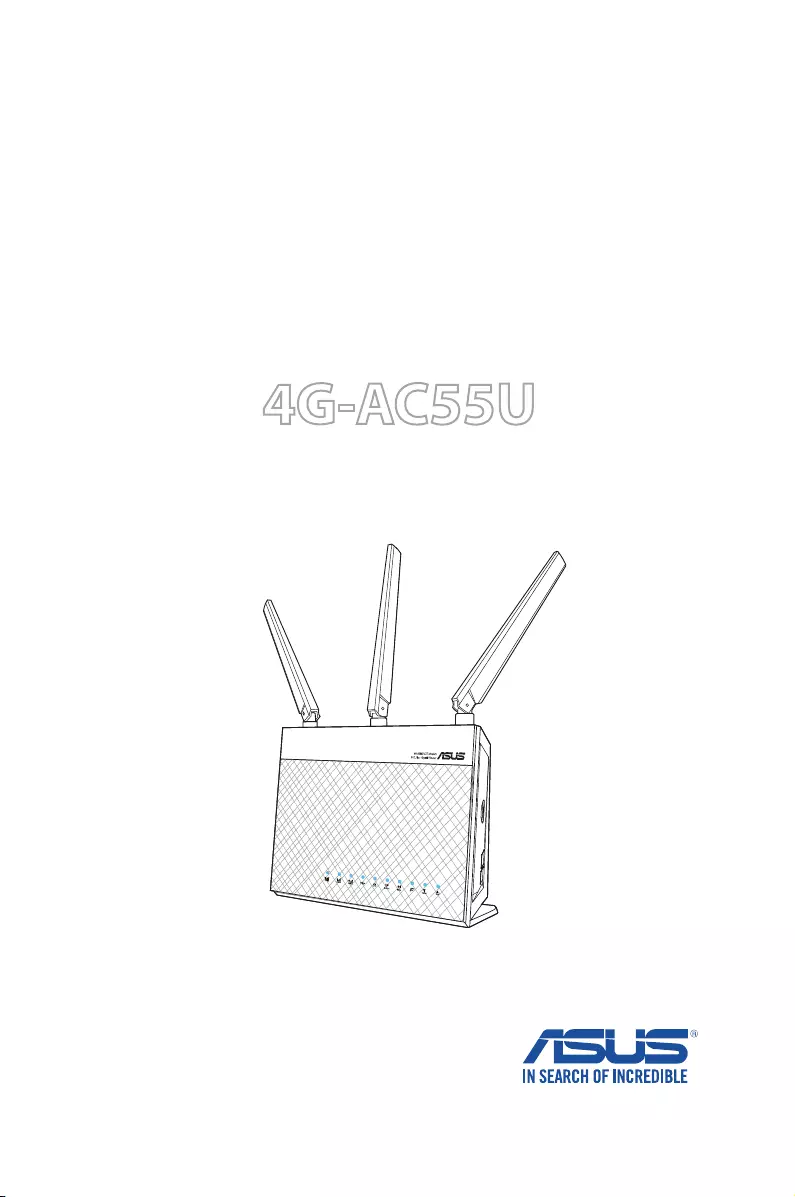
User Guide
4G-AC55U
Dual-Band Wireless-AC1200 LTE Modem Router

2
Copyright © 2015 ASUSTeK Computer Inc. All Rights Reserved.
No part of this manual, including the products and software described
in it, may be reproduced, transmitted, transcribed, stored in a retrieval
system, or translated into any language in any form or by any means, except
documentation kept by the purchaser for backup purposes, without the
express written permission of ASUSTeK Computer Inc. (“ASUS”).
Product warranty or service will not be extended if: (1) the product is repaired,
modified or altered, unless such repair, modification of alteration is authorized
in writing by ASUS; or (2) the serial number of the product is defaced or
missing.
ASUS PROVIDES THIS MANUAL “AS IS” WITHOUT WARRANTY OF ANY KIND,
EITHER EXPRESS OR IMPLIED, INCLUDING BUT NOT LIMITED TO THE IMPLIED
WARRANTIES OR CONDITIONS OF MERCHANTABILITY OR FITNESS FOR A
PARTICULAR PURPOSE. IN NO EVENT SHALL ASUS, ITS DIRECTORS, OFFICERS,
EMPLOYEES OR AGENTS BE LIABLE FOR ANY INDIRECT, SPECIAL, INCIDENTAL,
OR CONSEQUENTIAL DAMAGES (INCLUDING DAMAGES FOR LOSS OF PROFITS,
LOSS OF BUSINESS, LOSS OF USE OR DATA, INTERRUPTION OF BUSINESS
AND THE LIKE), EVEN IF ASUS HAS BEEN ADVISED OF THE POSSIBILITY OF
SUCH DAMAGES ARISING FROM ANY DEFECT OR ERROR IN THIS MANUAL OR
PRODUCT.
SPECIFICATIONS AND INFORMATION CONTAINED IN THIS MANUAL ARE
FURNISHED FOR INFORMATIONAL USE ONLY, AND ARE SUBJECT TO CHANGE
AT ANY TIME WITHOUT NOTICE, AND SHOULD NOT BE CONSTRUED AS A
COMMITMENT BY ASUS. ASUS ASSUMES NO RESPONSIBILITY OR LIABILITY
FOR ANY ERRORS OR INACCURACIES THAT MAY APPEAR IN THIS MANUAL,
INCLUDING THE PRODUCTS AND SOFTWARE DESCRIBED IN IT.
Products and corporate names appearing in this manual may or may not be
registered trademarks or copyrights of their respective companies, and are used
only for identification or explanation and to the owners’ benefit, without intent
to infringe.
E10633
Second Edition V2
June 2015

3
Table of contents
1 Getting to know your wireless router
1.1 Welcome! ...........................................................................................6
1.2 Package contents ............................................................................6
1.3 Your wireless router .......................................................................7
1.4 Device Properties ............................................................................9
1.5 Positioning your router .............................................................. 10
1.6 Installing your router .................................................................. 11
1.6.1 Prepare the setup requirements. .....................................11
1.6.2 Set up your LTE wireless router. .......................................12
2 Getting started
2.1 Quick Internet Setup (QIS) with Auto- detection ............. 14
3 Quick Look your Wireless Router
3.1 Using the Network Map ........................................................... 19
3.1.1 Setting up the wireless security settings ......................20
3.1.2 System Status .........................................................................21
3.1.3 Managing your network clients ....................................... 22
3.1.4 Monitoring the Internet Status ........................................24
3.1.5 Monitoring your USB device .............................................25
4 Configuring the Advanced Settings
4.1 Wireless............................................................................................ 26
4.1.1 General ......................................................................................26
4.1.2 WPS ............................................................................................28
4.1.3 WDS ............................................................................................30
4.1.4 Wireless MAC Filter ...............................................................32
4.1.5 RADIUS Setting .....................................................................33
4.1.6 Professional ............................................................................34
4.1.7 Guest Network .......................................................................37

4
Table of contents
4.2 LAN .................................................................................................... 39
4.2.1 LAN IP ........................................................................................39
4.2.2 DHCP Server ............................................................................40
4.2.3 Route .........................................................................................42
4.2.4 IPTV ............................................................................................43
4.2.5 Switch Control ........................................................................ 43
4.3 WAN .................................................................................................. 44
4.3.1 Internet Connection .............................................................44
4.3.2 IPv6 (Internet Settings) .......................................................53
4.3.3 Dual WAN .................................................................................54
4.3.4 Port Trigger ..............................................................................55
4.3.5 Virtual Server/Port Forwarding ........................................57
4.3.6 DMZ............................................................................................60
4.3.7 DDNS .........................................................................................61
4.3.8 NAT Passthrough ................................................................... 62
4.4 Traffic Manager ............................................................................. 63
4.4.1 QoS ............................................................................................. 63
4.4.2 Traffic Monitor ........................................................................ 65
4.4.3 Setting up Parental Controls ............................................. 67
4.5 Firewall ............................................................................................. 69
4.5.1 General ......................................................................................69
4.5.2 URL Filter ..................................................................................69
4.5.3 Keyword filter .........................................................................70
4.5.4 Network Services Filter .......................................................70
4.5.5 IPv6 Firewall ............................................................................71
4.6 Using the USB Application ....................................................... 72
4.6.1 Using AiDisk ............................................................................72
4.6.2 Using Servers Center ............................................................75
4.7 Download Master ........................................................................ 80
4.7.1 Configuring Bit Torrent download settings .................82

5
Table of contents
4.7.2 NZB settings ............................................................................ 83
4.7.3 eMule settings ........................................................................ 83
4.8 Using AiCloud 2.0 ........................................................................ 84
4.8.1 Cloud Disk ................................................................................85
4.8.2 Smart Access ........................................................................... 86
4.8.3 Smart Sync ............................................................................... 87
4.8.4 Sync Server ..............................................................................88
4.8.5 Settings ..................................................................................... 91
4.9 Administration .............................................................................. 92
4.9.1 Operation Mode ....................................................................92
4.9.2 System ....................................................................................... 93
4.9.3 Firmware Upgrade ................................................................ 95
4.9.4 Restore/Save/Upload Setting ...........................................96
4.10 System Log ..................................................................................... 97
4.11 Ethernet WAN Mobile Broadband Function Support List 98
5 Utilities
5.1 Device Discovery ........................................................................100
5.2 Firmware Restoration ...............................................................101
5.3 Setting up your printer server ............................................... 102
5.3.1 ASUS EZ Printer Sharing .................................................. 102
5.3.2 Using LPR to Share Printer .............................................. 106
6 Troubleshooting
6.1 Basic Troubleshooting ..............................................................111
6.2 Frequently Asked Questions (FAQs) ................................... 113
Appendices
Notices .....................................................................................................122
ASUS Contact information ..................................................................137
Networks Global Hotline Information.............................................138

6
1 Getting to know your wireless
router
1.1 Welcome!
Thank you for purchasing an ASUS 4G-AC55U Wireless Router!
The powerful and stylish 4G-AC55U features 2.4GHz and 5GHz
dual bands for an unmatched concurrent wireless HD streaming;
SMB server, UPnP AV server, and FTP server for 24/7 file sharing;
a capability to handle 300,000 sessions; and the ASUS Green
Network Technology, which provides up to 70% power-saving
solution.
1.2 Package contents
NOTES:
• Ifanyoftheitemsisdamagedormissing,contactyourretaileror
ASUS for technical inquiries and support, Refer to the ASUS Support
Hotline list at the back of this user manual.
• Keeptheoriginalpackagingmaterialincaseyouwouldneedfuture
warranty services such as repair or replacement.
4G-AC55U Wireless Router AC adapter
Network cable (RJ-45) Quick Start Guide
Support CD (User Manual) SIM adapter
2 x 3G/4G antennas

7
1.3 Your wireless router
3G/4G signal strength LED
1 lit LED: Weak signal
2 lit LEDs: Normal signal
3 lit LEDs: Strong signal
USB 2.0 LED
Off: No power or no physical connection.
On: Has physical connection to USB 2.0 devices.
LAN LED
Off: No data activity or no physical connection.
On: Ethernet connection is established.
2.4GHz Wi-Fi LED
Off: No 2.4GHz signal.
On: 2.4GHz wireless is ready.
Flashing: Transmitting or receiving data via wireless connection.
5GHz Wi-Fi LED
Off: No 5GHz signal.
On: 5GHz wireless is ready.
Flashing: Transmitting or receiving data via wireless connection.
WAN LED
Off: No data activity or no physical connection.
On: Has physical connection to a wide area network (WAN).
3G/4G Mobile Broadband LED
Off: No mobile broadband Internet connection.
Flashing: Establishing a LTE/Ethernet WAN connection.
On: Successfully established a Mobile Broadband Internet connection.
13 14 15 16 17
121 2 3 4 5 6 7 8 9 10 11
18
3G/4G antenna
3G/4G antenna
Wi-Fi antenna

8
NOTES:
• Useonlytheadapterthatcamewithyourpackage.Usingother
adapters may damage the device.
• EnsuretoinserttheSIMcardintothecardslotbeforepoweringon
the router.
Power LED
Off: No power.
On: Device is ready.
Flashing slow: Rescue mode
Flashing quick: WPS is processing.
SIM card slot
Install a USIM card with the bundled SIM adapter into this slot to establish a
Mobile Broadband Internet connection.
Mobile broadband signal button
Long press the button to show the signal strength. The number of LEDs (up to
10 LEDs) that light up indicate the signal strength.
WPS button
Long press the button to launch the WPS Wizard.
Power switch
Press this button to power on or off the system.
Power (DC-In) port
Insert the bundled AC adapter into this port and connect your router to a
power source.
USB 2.0 port
Insert USB 2.0 compatible devices such as USB hard disks or USB flash drives
into this port.
WAN port
Connect a network cable into this port to establish WAN connection.
16
Wi-Fi On/Off button
Press this button to turn on /off the Wi-Fi connection.
17
LAN ports
Connect network cables into these ports to establish LAN connection.
18
Reset button
This button resets or restores the system to its factory default settings.

9
1.4 Device Properties
Power Consumption:
• Input:AC230V/50HzV,DC19V/1.75A(EU)(UK)
• Maximumpowerconsumption:17.1W
• Averagepowerconsumption:11.4W
• Theaveragepowerconsumptionwasdeterminedatroom
temperature ( 23 °C to 27 °C ) with the following load:
• ActiveMobileBroadbandconnection
• WirelessLANon;nodevicesareconnectedtothewireless
LAN
• OnenetworkdeviceisconnectedtoaLANport;nodata
transfer; no network devices are connected to the other
LAN ports
Ambient conditions:
DC Power adapter DC Output: +19V with max 1.75A current
Operating Temperature 0~40oCStorage Temperature 0~70oC
Operating Humidity 10 ~ 90% Storage Humidity 5 ~ 95%

10
1.5 Positioning your router
For the best wireless signal transmission between the wireless
router and the network devices connected to it, ensure that you:
• PlacethewirelessLTErouternearawindowtoreceivethe
bestqualityformaximumwirelessupstreamperformance
withanLTEbasestation.
• Keepthedeviceawayfrommetalobstructionsandawayfrom
directsunlight.
• DonotplacetheWirelessLTERouterinadustyorwet
environment.
• Topreventsignalloss,keepthedeviceawayfrom802.11g
or20MHzonlyWi-Fidevices,2.4GHzcomputerperipherals,
Bluetoothdevices,cordlessphones,transformers,heavy-duty
motors,fluorescentlights,microwaveovens,refrigerators,and
otherindustrialequipment.
• Alwaysupdatetothelatestfirmware.VisittheASUSwebsiteat
http://www.asus.comtogetthelatestfirmwareupdates.
• Toensurethebestwirelesssignal,orientthetwodetachable
antennasasshowninthedrawingbelow.

11
1.6 Installing your router
1.6.1 Prepare the setup requirements.
To set up your wireless network, you need to meet the following
requirements:
• AminiSIM/USIMcardwithWCDMAandLTEsubscription
IMPORTANT!
• Ensure that your SIM/USIM card is subscribed to WCDMA and LTE
services. Contact your mobile service provider about these services.
• Ifyouusea3rdpartyadapter,ensurethatyoucutotheportion
marked in red above to avoid stocking the SIM adapter in SIM slot.
CAUTION! Use only a standard SIM/USIM card with the bundled SIM
adapter on your router. Using a different form of SIM card type, such as
micro or nano SIM card, may result to a stuck SIM card and may damage
your router.
• AnADSL/cablemodemwithInternetsubscription
• AcomputerwithEthernetRJ-45(LAN)port(10/100/1000
Base-TX) or a Wi-Fi-enabled device with a 2.4 GHz and 5 GHz
802.11 a/b/g/n/ac wireless interface
• WebbrowsersuchasInternetExplorer,Firefox,Safari,or
Google Chrome

12
1.6.2 Set up your LTE wireless router.
a. Attach the two 3G/4G antennas.
b. Insert the SIM/USIM card into the USIM card slot. When the
SIM/USIM card is properly installed, the Mobile Broadband
LED lights up and flashes slowly after power on. See Install
SIM/USIM card into your router.
c. Insert the AC adapter of your router to the DC-IN port and
plug it to a power outlet.
d. Turn on your router.
e. Using a network cable, connect your modem to the WAN port
of your router. When the network cable is properly connected,
the WAN LED lights up.
f. Insert the AC adapter of your modem to the DC-IN port and
plug it to a power outlet.
NOTE: You can use either 3G/4G or wired Ethernet connection for
Internet access.
g. Using the bundled network cable, connect your computer to
the LAN port of your router.
Computer
Wall Power Outlet
Modem
Power
WAN
c
e
d
f
b
LAN
g
aa

13
2. Pull out the tray.
3. Place the SIM/USIM card on the tray and push the tray all the
way into the slot.
PIN hole Paper clip
Manually connecting to a wireless network
NOTE: Ensure that you press the Wi-Fi button on your router.
1. Enable the Wi-Fi function on your wireless client for it to
automatically scan for wireless networks.
2. Select the wireless network named “ASUS” or “ASUS_5G”,
which is the default wireless network name (SSID) of ASUS
wireless routers.
Installing SIM/USIM card into your router
NOTES:
• UseonlythebundledSIMadapter.
• AlwaysinserttheSIMadapterwithaMicroSIMcardorNanoSIM
card. The SIM adapter might get stuck if it is inserted alone.
Bundled SIM
Adapter 1
Micro SIM Bundled SIM
Adapter 2
Nano SIM
1. Find the SIM card tray at the side of the router.
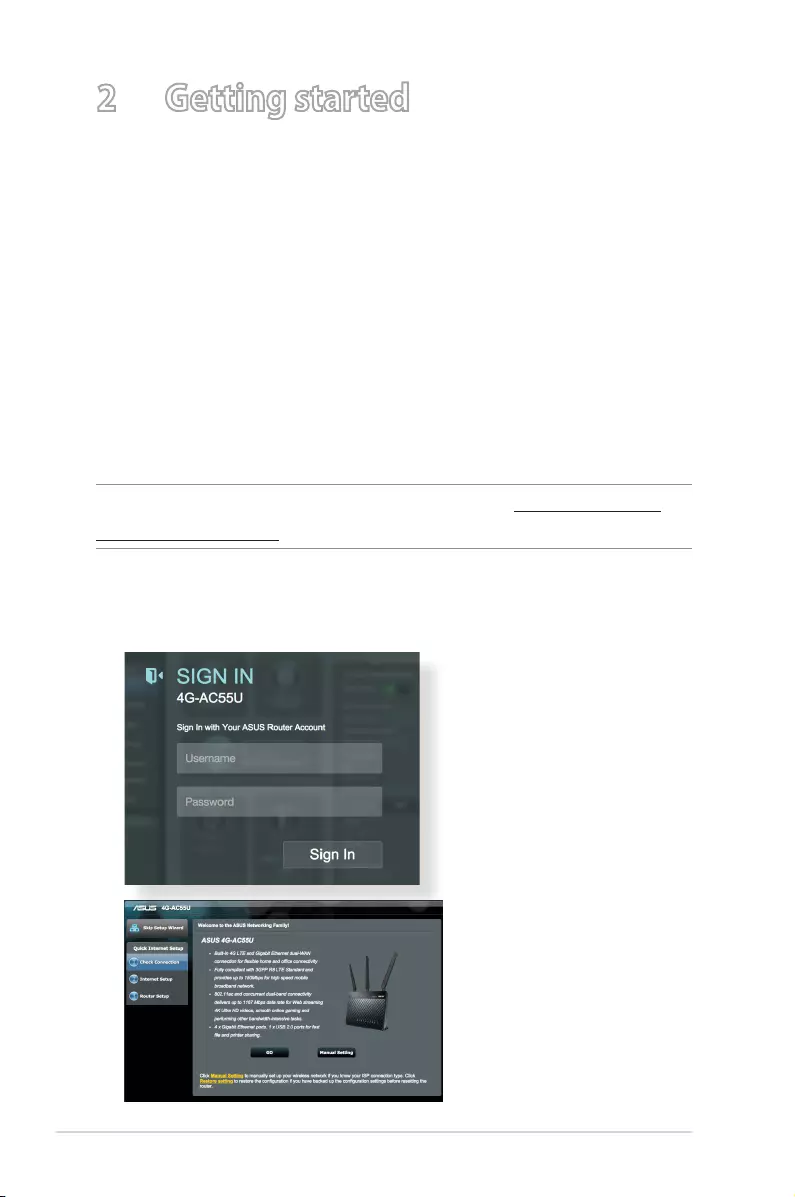
14
2 Getting started
2.1 Quick Internet Setup (QIS) with Auto-
detection
To set up your router using QIS (Quick Internet Setup):
1. Press the power button at the back of your router. Ensure that
the following LEDs light up:
• PowerLED • 2.4GHzWi-FiLED
• WANorMobile
Broadband LED
• 5GHzWi-FiLED
2. Launch your web browser such as Internet Explorer, Firefox,
Google Chrome, or Safari.
NOTE: If QIS does not launch automatically, enter http://192.168.1.1 or
http://router.asus.com in the address bar and refresh the browser again.
3. Log into the Web GUI. The QIS page launches automatically.
By default, the login username and password for your router’s
Web GUI is “admin”.
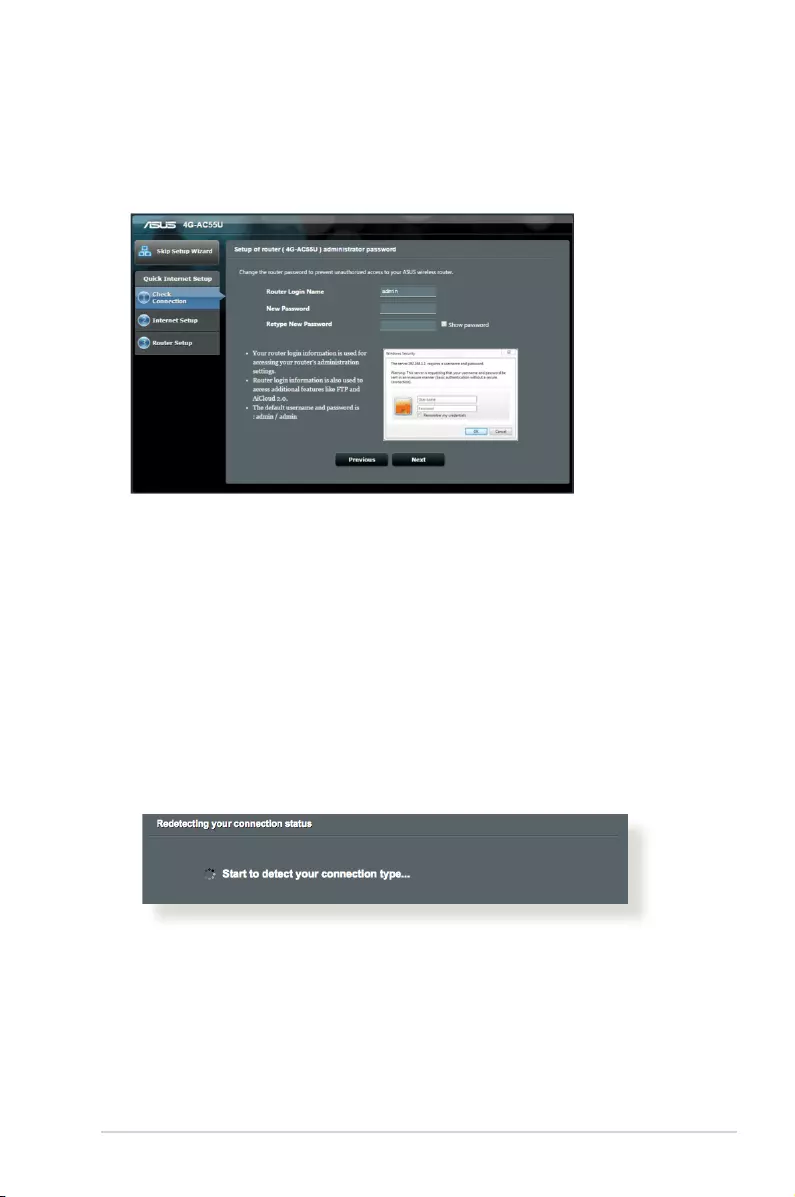
15
4. Assign your router login name and password and click Next.
You need this login name and password to log into 4G-AC55U
to view or change the router settings. You can take note of
your router login name and password for future use.
5. If the WAN port is connected, the wireless router’s Quick
Internet Setup (QIS) feature automatically detects if your ISP
connection type is Dynamic IP, PPPoE, PPTP, L2TP, and
Static IP. Please obtain the necessary information from your
Internet Service Provider (ISP). If your connection type is
Dynamic IP (DHCP), QIS wizard will automatically direct you to
the next step.
for Automatic IP (DHCP)
The DHCP server automatically assigns the IP address.

16
for PPPoE, PPTP, and L2TP
You need to key in the account name and password that you
obtained from your ISP for Internet connection.
for Static IP
You need to manually configure the IP address.
6. If a 3G/4G network is connected, the wireless router’s Quick
Internet Setup (QIS) feature automatically detects and applies
the APN setting to connect to the wireless base station. If the
QIS wizard failed to automatically apply the APN setting or
the SIM card prompts for a PIN code, set up the APN setting
manually.
NOTE: The PIN code may vary from different providers.

17
7. The dual WAN connection configuration result is displayed.
Click Next to continue.
Mobile Broadband Connection is configured successfully
Ethernet WAN Connection is configured successfully
8. If both WAN are configured, go to next step to configure the
wireless LAN settings.

18
9. Assign the network name (SSID) and security key for your
2.4GHz and 5GHz wireless connection. Click Apply when
done.
10. Your Internet and wireless settings are displayed. Click Next
to complete the QIS process.
11. The 3G/4G signal strength LED lights up and is steady after
completing the 3G/4G network settings via QIS, indicating a
successful Internet connection.

19
3 Quick Look your Wireless Router
3.1 Using the Network Map
Network Map allows you to check the Internet connection status,
configure your network’s security settings, and manage your
network clients.

20
3.1.1 Setting up the wireless security settings
Toprotectyourwirelessnetworkfromunauthorizedaccess,you
needtoconfigureitssecuritysettings.
To set up the wireless security settings:
1. From the navigation panel, go to General > Network Map.
2. OntheNetworkMapscreen,clickSystemstatusicon .
Youcanconfigurethewirelesssecuritysettingssuchas
wireless name(SSID),authentication method,and
encryption settings.
2.4GHz security settings 5GHz security settings

21
3. OntheWireless name (SSID)field,keyinauniquenamefor
yourwirelessnetwork.
4. FromtheAuthentication Methoddropdownlist,selectthe
authenticationmethodforyourwirelessnetwork.
IfyouselectWPA-PersonalorWPA-2 Personalasthe
authenticationmethod,keyintheWPA-PSKkeyorsecurity
passkey.
IMPORTANT! The IEEE 802.11n/ac standard prohibits using Low
Throughput with WEP or WPA-TKIP as the unicast cipher. If you use these
encryption methods, your data rate will drop to IEEE 802.11g 54Mbps
connection.
5 ClickApplywhendone.
3.1.2 System Status
To monitor the system resources:
1. From the navigation panel, go to General > Network Map.
2. OntheNetworkMapscreen,clicktheSystemstatusicon .
youcanfindtheinformationaboutCPUandmemoryusage.

22
3.1.3 Managing your network clients
To manage your network clients:
1. From the navigation panel, go to General > Network Map
tab.
2. On the Network Map screen, select the Client Status icon
to display your network client’s information.

23
3. On Client status table, click the device icon to show the
detailed profile of the device. To block a client’s access to your
network, select the client and click block icon .

24
3.1.4 Monitoring the Internet Status
To monitor your Internet status:
1. From the navigation panel, go to General > Network Map
tab.
2. On the Network Map screen, select the Internet icon
to display your Internet configuration.
3. To terminate WAN interface from your network, click Disable
button on Terminate WAN Interface.
Primary WAN Secondary WAN

25
3.1.5 Monitoring your USB device
The ASUS wireless router provides one USB port for connecting
USB devices or USB printer to allow you to share files and printer
with clients in your network.
To monitor your USB device:
1. From the navigation panel, go to General > Network Map
tab.
2. On the Network Map screen, select the USB Disk Status icon
to display your USB device’s information.
3. On the Media Server field, click GO to set up an iTune and
DLNA server for local media file sharing.
NOTE: The wireless router works with most USB HDDs/Flash disks (up
to 2 TB size) and supports read-write access for FAT16, FAT32, EXT2,
EXT3, and NTFS.
4. On the AiDisk Wizard field, click GO to set up an FTP server
for Internet file sharing.
5. To eject USB Disk from USB interface, click Remove button
on Safely Remove disk field. When the USB disk is ejected
successfully, the USB status shows Unmounted.

26
4 Configuring the Advanced Settings
4.1 Wireless
4.1.1 General
The General tab allows you to configure the basic wireless
settings.
To configure the basic wireless settings:
1. From the navigation panel, go to Advanced Settings >
Wireless > General tab.
2. Configure wireless basic configuration for 2.4GHz or 5GHz
frequency band.
3. In the SSID field, assign a unique name containing up to 32
characters for your SSID (Service Set Identifier) or network
name to identify your wireless network. Wi-Fi devices can
identify and connect to the wireless network via your
assigned SSID. The SSIDs on the information banner are
updated once new SSIDs are saved to the settings.

27
4. In the Hide SSID field, select Ye s to prevent wireless devices
from detecting your SSID. When this function is enabled, you
would need to enter the SSID manually on the wireless device
to access the wireless network.
5. In the Wireless Mode field, select any of these wireless mode
options to determine the types of wireless devices that can
connect to your wireless router:
• Auto: Select Auto to allow 802.11ac, 802.11n, 802.11g,
802.11b and 802.11a devices to connect to the wireless
router.
• Legacy: Select Legacy to allow 802.11b/g/n devices to
connect to the wireless router. Hardware that supports
802.11n natively, however, will only run at a maximum speed
of 54Mbps.
• b/g Protection: Tick b/g Protection to allow wireless router
protect 802.11n transmissions performance from legacy
devices with 802.11g, 802.11b connection.
6. In the Control Channel field, select the operating channel for
your wireless router. Select Auto to allow the wireless router
to automatically select the channel that has the least amount
of interference.
7. In the Channel bandwidth field, select any of these channel
bandwidth to accommodate higher transmission speeds:
• 20/40MHz (default): Select this bandwidth to automatically
select the best bandwidth for your wireless environment. In
5GHz band, the default bandwidth 20/40/80MHz is selected.
• 80MHz: Select this bandwidth to maximize the wireless
throughput of 5GHz radio.
• 40MHz: Select this bandwidth to maximize the wireless
throughput of 2.4GHz radio.
• 20MHz: Select this bandwidth if you encounter some issues
with your wireless connection.
8. If 20/40/80MHz, 20/40MHz, 40MHz or 80MHz is selected,
you can define a upper or lower adjacent channel in the
Extension Channel field to be accommodated
9. In the Authentication Method field, select any of these
authentication methods:

28
• Open System: This option provides no security.
• WPA2-Personal / WPA Auto-Personal: This option
provides strong security. You can use either WPA2-
Personal (with AES) or WPA Auto-Personal (with AES or
TKIP + AES). If you select this option, you must enter the
WPA Pre-Shared Key (network key).
• WPA2 Enterprise / WPA Auto-Enterprise: This option
provides very strong security. It is with integrated EAP
server or an external RADIUS back-end authentication
server.
11. When done, click Apply.
4.1.2 WPS
WPS (Wi-Fi Protected Setup) is a wireless security standard that
allows you to easily connect devices to a wireless network. You
can configure the WPS function via the PIN code or WPS button.
NOTE: Ensure that the devices support WPS.

29
To enable WPS on your wireless network:
1. From the navigation panel, go to Advanced Settings >
Wireless > WPS tab.
2. In the Enable WPS field, move the slider to ON.
3. WPS uses 2.4GHz and 5GHz radio concurrently.
4. You can use any of the following WPS methods for wireless
connection pairing:
• PBC (Push Button Configuration) Mode:
• HardwarePBContherouter:PressthephysicalWPS
button on wireless router, and then press WPS button on
wireless client for three (3) minutes.
• SoftwarePBContherouter:Tick<Pushbutton>onWPS
Method field, click Start, and then press the WPS button
on the wireless client for three (3) minutes.
• PIN Code Mode:
• Pairingfromthewirelessclient:PresstheWPSbuttonon
the wireless router, and then perform WPS connection
process in PIN code mode and enter the AP PIN Code on
the client device.
• Pairingfromthewirelessrouter:PresstheWPSbutton
on wireless client, and then perform the WPS connection
process in PIN code mode and enter the Client PIN Code
on the WPS Method > Client PIN Code filed. Check if
the PIN code is correct and then click Start to pair with
wireless client.
NOTES:
• WPSsupportsauthenticationusingOpenSystemandWPA2-
Personal. WPS does not support a wireless network that uses a
Shared Key, WPA-Personal, WPA-Enterprise, WPA2-Enterprise, and
RADIUS encryption method.
• Checkyourwirelessdeviceoritsusermanualforthelocationofthe
WPS button.
• DuringtheWPSprocess,thewirelessrouterscansforanyavailable
WPS devices. If the wireless router does not find any WPS devices, it
switches to idle mode.
• Therouter’spowerLEDindicatorsquicklyflashthreeminutesuntil
the WPS setup is completed.

30
4.1.3 WDS
Bridge or WDS (Wireless Distribution System) allows your ASUS
wireless router to connect to another wireless access point
exclusively, preventing other wireless devices or stations to access
your ASUS wireless router. It can also be considered as a wireless
repeater where your ASUS wireless router communicates with
another access point and other wireless devices.
To set up the wireless bridge:
1. From the navigation panel, go to Advanced Settings >
Wireless > WDS tab.

31
2. Select the band for the wireless bridge.
3. In the AP Mode field, select any of these options:
• AP Only: Disables the WDS function.
• WDS Only: Enables the WDS feature but prevents other
wireless devices/stations from connecting to the router.
• HYBRID: Enables the Wireless Bridge feature and allows
other wireless devices/stations to connect to the router.
4. In the Connect to APs in list field, click Yes if you want to
connect to an Access Point listed in the Remote AP List.
5. On the Remote AP List, key in a MAC address and click the
Add button to enter the MAC address of other available
Access Points
6. Click Apply.
NOTES:
• InHybridmode,wirelessdevicesconnectedtotheASUSwireless
router only receives half the connection speed of the Access Point.
• AnyAccessPointaddedtothelistshouldbeonthesameControl
Channel and the same fixed Channel bandwidth as the local ASUS
wireless router. You can modify the Control Channel from Advanced
Settings > Wireless > General tab.
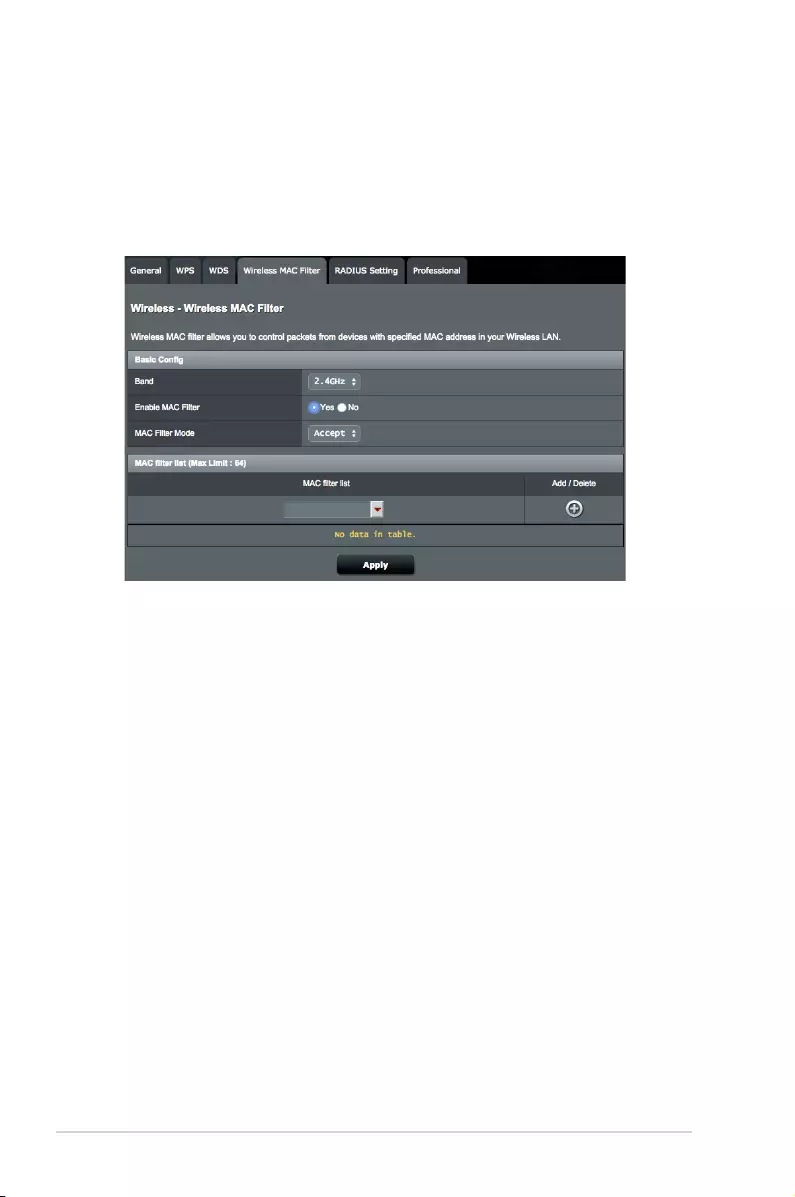
32
4.1.4 Wireless MAC Filter
Wireless MAC filter provides control over packets transmitted to
a specified MAC (Media Access Control) address on your wireless
network.
To set up the Wireless MAC filter:
1. From the navigation panel, go to Advanced Settings >
Wireless > Wireless MAC Filter tab.
2. Tick Yes in the Enable Mac Filter field.
3. In the MAC Filter Mode dropdown list, select either Accept or
Reject.
• SelectAccept to allow devices in the MAC filter list to access
to the wireless network.
• SelectReject to prevent devices in the MAC filter list to access
to the wireless network.
4. On the MAC filter list, click the Add button and key in the
MAC address of the wireless device.
5. Click Apply.

33
4.1.5 RADIUS Setting
RADIUS (Remote Authentication Dial In User Service) Setting
provides an extra layer of security when you choose WPA-
Enterprise, WPA2-Enterprise, or Radius with 802.1x as your
Authentication Mode.
To set up the wireless RADIUS settings:
1. Ensure that the wireless router’s authentication mode is set to
WPA-Enterprise or WPA2-Enterprise.
NOTE: Please refer to section 4.1.1 General for configuring your
wireless router’s Authentication Mode.
2. From the navigation panel, go to Advanced Settings >
Wireless > RADIUS Setting.
3. Select the frequency band.
4. In the Server IP Address field, key in your RADIUS server’s IP
Address.
5. In the Server Port field, key in the server port.
6. In the Connection Secret field, assign the password to access
your RADIUS server.
7. Click Apply.

34
4.1.6 Professional
The Professional screen provides advanced configuration options.
NOTE: We recommend that you use the default values on this page.
In the Professional Settings screen, you can configure the
following:
• Frequency: Select the frequency band that the professional
settings will be applied to.
• Enable Radio: Select Yes to enable wireless networking.
Select No to disable wireless networking.

35
• Enable wireless scheduler: Select Ye s to enable wireless
networking by the following schedule rules. Select No to
disable the schedule rules.
• Date to Enable Radio (weekdays): You can specify which
days of the week wireless networking is enabled.
• Time of Day to Enable Radio: You can specify a time range
when wireless networking is enabled during the week.
• Date to Enable Radio (weekend): You can specify which
days of the weekend wireless networking is enabled.
• Time of Day to Enable Radio: You can specify a time range
when wireless networking is enabled during the weekend.
• Set AP isolated: The Set AP isolated item prevents wireless
devices on your network from communicating with each
other. This feature is useful if you want to create a public
wireless network that only allow guests to access the
Internet. Select Yes to enable this feature or select No to
disable.
• Roaming Assistant: When your wireless environment
has provisioned a several APs (access point) or wireless
repeaters to cover all wireless dead zones. When a client that
connected on AP1 moves from one place with better signal
to another with poor signal, but there is an another signal
from AP2. To prevent the client stick on AP1, you can enable
Roaming Assistant, and set a minimal RSSI value as threshold.
When the connection quality lower than the threshold, AP1
disconnect the wireless client so that it can reevaluate the
wireless environment to select a AP with the best signal
quality, such as AP2.
• Enable IGMP Snooping: When IGMP snooping is enabled,
multicast traffic is only forwarded to wireless client that are
members of the specific multicast group.
• Multicast rate (Mbps): Select the multicast transmission
rate or click Disable to switch off simultaneous single
transmission.

36
• Preamble Type: Preamble Type defines the length of time
that the router spent for CRC (Cyclic Redundancy Check). CRC
is a method of detecting errors during data transmission.
Select Short for a busy wireless network with high network
traffic. Select Long if your wireless network is composed of
older or legacy wireless devices.
• AMPDU RTS: In 802.11n or 802.11ac using a method,
A-MPDU, to aggregate short packet into a longer packet for
the same MAC address. When a wireless device ready for
transmission sends a RTS (Request to Send). After enabling
AMPDU RTS, every AMPDU frame send with RTS process.
• RTS Threshold: Select a lower value for RTS (Request to
Send) Threshold to improve wireless communication in a
busy or noisy wireless network with high network traffic and
numerous wireless devices.
• DTIM Interval: DTIM (Delivery Traffic Indication Message)
Interval or Data Beacon Rate is the time interval before a
signal is sent to a wireless device in sleep mode indicating
that a data packet is awaiting delivery. The default value is
three milliseconds.
• Beacon Interval: Beacon Interval is the time between one
DTIM and the next. The default value is 100 milliseconds.
Lower the Beacon Interval value for an unstable wireless
connection or for roaming devices.
• Enable TX Bursting: Enable TX Bursting improves
transmission speed between the wireless router and 802.11g
devices.
• Enable WMM APSD: WMM APSD(Automatic Power Save
Delivery) is the enhancement to the legacy power saver
mode. Enable WMM APSD, the wireless AP manages radio
usage to help increase battery life for battery-powered
wireless clients, such as smartphone and laptop. APSD
automatically changes to use a longer beacon interval when
the traffic does not require a short packet exchange interval.

37
4.1.7 Guest Network
The Guest Network provides temporary visitors with Internet
connectivity via access to separate SSIDs or networks without
providing access to your private network.
To create a guest network:
1. From the navigation panel, go to General > Guest Network.
2. On the Guest Network screen, select 2.4Ghz and 5Ghz
frequency band for the guest network that you want to create.
3. Click Enable.
4. Configure a guest’s settings on pop-up screen
5. Assign a Network Name (SSID) for identify your guest
network.
6. Select an Authentication Method.
7. If you select a WPA authentication method, select a WPA
Encryption.
8. Specify the Access time or choose Limitless.

38
11. When done, click Apply.
9. Select Disable or Enable on the Access Intranet item.
10. Select No or Yes on MAC Filter item for your guest network.

39
4.2 LAN
4.2.1 LAN IP
The LAN IP screen allows you to modify the LAN IP settings of your
wireless router.
NOTE: Any changes to the LAN IP address will be reflected on your
DHCP settings.
To modify the LAN IP settings:
1. From the navigation panel, go to Advanced Settings > LAN
> LAN IP tab.
2. Modify the IP address and Subnet Mask.
3. When done, click Apply.

40
4.2.2 DHCP Server
Your wireless router uses DHCP to assign IP addresses
automatically on your network. You can specify the IP address
range and lease time for the clients on your network.
To configure the DHCP server:
1. From the navigation panel, go to Advanced Settings > LAN
> DHCP Server tab.
2. In the Enable the DHCP Server field, tick Yes .
3. In the Domain Name text box, enter a domain name for the
wireless router.
4. In the IP Pool Starting Address field, key in the starting IP
address.

41
5. In the IP Pool Ending Address field, key in the ending IP
address.
6. In the Lease Time field, specify in seconds when an assigned
IP address will expire. Once it reaches this time limit, the DHCP
server will then assign a new IP address.
NOTES:
• We recommend that you use an IP address format of 192.168.1.xxx
(where xxx can be any number between 2 and 254) when specifying
an IP address range.
• AnIPPoolStartingAddressshouldnotbegreaterthantheIPPool
Ending Address.
7. In the DNS and Server Settings section, key in your DNS
Server and WINS Server IP address if needed.
8. Your wireless router can also manually assign IP addresses to
devices on the network. On the Enable Manual Assignment
field, choose Yes to assign an IP address to specific MAC
addresses on the network. Up to 32 MAC Addresses can be
added to the DHCP list for manual assignment.

42
4.2.3 Route
If your network makes use of more than one wireless router, you
can configure a routing table to share the same Internet service.
NOTE: We recommend that you do not change the default route
settings unless you have advanced knowledge of routing tables.
To configure the LAN Routing table:
1. From the navigation panel, go to Advanced Settings > LAN
> Route tab.
2. On the Enable static routes field, choose Yes.
3. On the Static Route List, enter the network information of
other access points or nodes. Click the Add or Delete
button to add or remove a device on the list.
4. Click Apply.

43
4.2.4 IPTV
The wireless router supports connection to IPTV services through
an ISP or a LAN. The IPTV tab provides the configuration settings
needed to set up IPTV, VoIP, multicasting, and UDP for your
service. Contact your ISP for specific information regarding your
service.
4.2.5 Switch Control
Switch Control tab enables you to configure NAT Acceleration and
Jumbo frame to improve network performance. We recommend
that you do not change the default route settings unless you have
advanced knowledge.

44
4.3 WAN
4.3.1 Internet Connection
The Internet Connection screen allows you to configure the
settings of various WAN connection types.
4.3.1.1 WAN
To configure the WAN connection settings:
1. From the navigation panel, go to Advanced Settings > WAN
> Internet Connection tab.
2. Configure the following settings below. When done, click
Apply.
• WAN Connection Type: Choose your Internet Service
Provider type. The choices are Automatic IP, PPPoE, PPTP,
L2TP or static IP. Consult your ISP if the router is unable
to obtain a valid IP address or if you are unsure the WAN
connection type.

45
• Enable WAN: Select Ye s to allow the router Internet access.
Select No to disable Internet access.
• Enable NAT: NAT (Network Address Translation) is a system
where one public IP (WAN IP) is used to provide Internet
access to network clients with a private IP address in a LAN.
The private IP address of each network client is saved in a
NAT table and is used to route incoming data packets.
• Enable UPnP: UPnP (Universal Plug and Play) allows several
devices (such as routers, televisions, stereo systems, game
consoles, and cellular phone), to be controlled via an IP-
based network with or without a central control through a
gateway. UPnP connects PCs of all form factors, providing
a seamless network for remote configuration and data
transfer. Using UPnP, a new network device is discovered
automatically. Once connected to the network, devices
can be remotely configured to support P2P applications,
interactive gaming, video conferencing, and web or proxy
servers. Unlike Port forwarding, which involves manually
configuring port settings, UPnP automatically configures the
router to accept incoming connections and direct requests to
a specific PC on the local network.
• Connect to DNS Server automatically: Allows this router
to get the DNS IP address from the ISP automatically. A DNS
is a host on the Internet that translates Internet names to
numeric IP addresses.
• Authentication: This item may be specified by some ISPs.
Check with your ISP and fill them in if required.
• Host Name: This field allows you to provide a host name for
your router. It is usually a special requirement from your ISP.
If your ISP assigned a host name to your computer, enter the
host name here.
• MAC Address: MAC (Media Access Control) address is a
unique identifier for your networking device. Some ISPs
monitor the MAC address of networking devices that connect
to their service and reject any unrecognized device that
attempt to connect. To avoid connection issues due to an
unregistered MAC address, you can:

46
• ContactyourISPandupdatetheMACaddressassociated
with your ISP service.
• CloneorchangetheMACaddressoftheASUSwireless
router to match the MAC address of the previous
networking device recognized by the ISP.
• DHCP query frequency: Changes the DHCP Discovery
interval settings to avoid overloading the DHCP server.
4.3.1.2 Mobile broadband
4G-AC55U has build in 3G/4G modem that allows you to use a
Mobile Broadband connection for Internet access.
To set up your Mobile broadband Internet access:
1. From the navigation panel, go to Advanced Settings > WAN
> Internet Connection tab, select the Mobile Broadband in
WAN Type field.
2. In the Enable Mobile Broadband field, select Enable.
3. Check that you have properly inserted the SIM card, and
configure the mobile settings of your router.

47
4. Set up the following:
• Location: Select your 3G/4G service provider’s location from
the dropdown list.
• ISP: Select your Internet Service Provider (ISP) from the
dropdown list.
• APN (Access Point Name) service (optional): Contact your
3G/4G service provider for detailed information.
• Dial Number: The 3G/4G provider’s access number
• PIN code: Enter the 3G/4G provider’s PIN code for
connection on SIM PIN Management if the SIM card is
required.
NOTE:
• ThedefaultPINcodemayvarywithdifferentproviders.
• Whenyousetupforthefirsttimeorrebootyourrouter,youneedto
enter the PIN code in any of thee two scenarios:
•YourISPenabledthePINcodeverificationbydefault.
•YoumanuallyenabledthePINcodeverificationfromyourrouter's
web GUI or your mobile phone.
• IfPINcodeverificationisenabled,youwillseetheSIMlockstatus
icon on the status icon area.

48
Internet Connection Configuration
To configure your mobile broadband connection:
1. On Network Type field, select your preferred network:
• Auto (Default): Select Auto to allow the wireless router
to automatically select the channel that has the available
connection from 4G, 3G and 2G network.
• Username / Password: Enter the username and password
that your 3G/4G network provider has provided.
• Idle Time: Enter the time (in minutes) when the router goes
into sleep mode when there is no activity in the network.

49
• 3G/4G: Select 3G/4G to allow the wireless router to
automatically connect to a 3G or 4G network.
• 4G only: Select this option to automatically connect the
wireless router to a 4G network only.
• 3G only: Select this option to automatically connect the
wireless router to a 3G network only.
• 2G only: Select this option to automatically connect the
wireless router to a 2G network only.
2. Connection Type: This field allows you to define your
connection policies.
3. PDP Type: The wireless router support several PDP Types,
PPP, IPv4, IPv6, IPv6 to IPv4.
4. Roaming : When you travel to another country, you may use
original SIM to access the local network if your ISP provider
roaming service in the country. Enable this functions to allow
you to access the local network.
• ClickScan to show all the available mobile networks.
• SelectavailablemobilenetworkandclickApply to connect
to it.
NOTES:
• TheLTERoutercandetectyourISPbasedontheIMSIinformation
of your SIM card. If the mobile network from your ISP is not found,
connect to a roaming network of other ISPs.
• Usingaroamingservicewillincuradditionalcharges.Inquirefrom
your mobile service provider before using the roaming service.

50
Traffic Limitation
To configure the Data Usage settings:
1. Data usage: Show the data usage.
2. Cycle Start Day: Select the day you wish the data usage to
begin to accumulate. The data usage will be reset at the end
of each cycle.
3. Data Usage Limit: Set the monthly maximum volume of
traffic (in GB) for Internet usage. When this limit is reached,
an exclamation mark and pop-up alert message will show up
when you login administration page, and Internet access is
blocked.
4. Data Usage Alert: Set the maximum volume of Internet traffic
at which an exclamation mark and pop-up alert message will
show up when you login administration page. When your
Internet usage reaches this limit, Internet access is not blocked
until the Usage Limit is reached.
5. Send SMS notification: Enable this function to send an SMS
notification from your router to your mobile device once the
Data Usage limit for Internet usage is reached.
6. Mobile Phone Number: Enter the mobile number that is
going to receive the SMS notification.
Note: The SMS fee is charged to your SIM/USIM card of your router.
7. Click Apply.

51
Configure PIN Code
Enter PIN code if SIM card is required you to enter a PIN Code
before apply APN connection.
You can also click Modify button to change PIN code when PIN
code authentication is enable.

52
Mobile Connection Status
To find Mobile broadband Information:
1. Click to find the detail information
2. The Mobile Connection Status screen displays the detailed
Mobile Broadband connection status.

53
4.3.2 IPv6 (Internet Settings)
This wireless router supports IPv6 addressing, a system that
supports more IP addresses. This standard is not yet widely
available. Contact your ISP if your Internet service supports IPv6.
To set up IPv6:
1. From the navigation panel, go to Advanced Settings > IPv6.
2. Select your Connection Type. The configuration options vary
depending on your selected connection type.
3. Enter your IPv6 LAN and DNS settings.
4. Click Apply.
NOTE: Please refer to your ISP regarding specific IPv6 information for
your Internet service.

54
4.3.3 Dual WAN
Your ASUS wireless router provides dual WAN support. You can set
the dual WAN feature to any of these two modes:
• Failover Mode: Select this mode to use the secondary WAN
as the backup network access.
• Allow Failback: Tick the checkbox to allow Internet
connection switch back to primary WAN automatically when
primary WAN becomes available.
• First time delay: Set the time delay (in seconds) before the
first ping packet is sent out.
• Retry interval: Set the time interval (in seconds) between
two ping packets.
• Failover Retry Count: Set the time (in seconds) when the
system triggers the failover or failback action after reaching

55
4.3.4 Port Trigger
Port range triggering opens a predetermined incoming port for a
limited period of time whenever a client on the local area network
makes an outgoing connection to a specified port. Port triggering
is used in the following scenarios:
• More than one local client needs port forwarding for the
same application at a different time.
• An application requires specific incoming ports that are
different from the outgoing ports.
To set up Port Trigger:
1. From the navigation panel, go to Advanced Settings > WAN
> Port Trigger tab.
the ping test counter and getting no response from the target
IP address.
• Enable User-defined Target: Select Yes when you want to
manually define the target IP address or FQDN (Fully Qualified
Domain Name) for the ping test packet.

56
2. On the Enable Port Trigger field, tick Yes.
3. On the Well-Known Applications field, select the popular
games and web services to add to the Port Trigger List.
4. On the Trigger Port List table, key in the following
information:
• Description: Enter a short name or description for the
service.
• Trigger Port: Specify a trigger port to open the incoming
port.
• Protocol: Select the protocol, TCP, or UDP.
• Incoming Port: Specify an incoming port to receive inbound
data from the Internet.
• Protocol: Select the protocol, TCP, or UDP.
5. Click the Add button to enter the port trigger information
to the list. Click the Delete button to remove a port
trigger entry from the list.
6. When done, click Apply.
NOTES:
• WhenconnectingtoanIRCserver,aclientPCmakesanoutgoing
connection using the trigger port range 66660-7000. The IRC server
responds by verifying the username and creating a new connection
to the client PC using an incoming port.
• IfPortTriggerisdisabled,therouterdropstheconnectionbecause
it is unable to determine which PC is requesting for IRC access.
When Port Trigger is enabled, the router assigns an incoming port to
receive the inbound data. This incoming port closes once a specific
time period has elapsed because the router is unsure when the
application has been terminated.
• Porttriggeringonlyallowsoneclientinthenetworktousea
particular service and a specific incoming port at the same time.
• Youcannotusethesameapplicationtotriggeraportinmorethan
one PC at the same time. The router will only forward the port back
to the last computer to send the router a request/trigger.

57
4.3.5 Virtual Server/Port Forwarding
Port forwarding is a method to direct network traffic from the
Internet to a specific port or a specific range of ports to a device
or number of devices on your local network. Setting up Port
Forwarding on your router allows PCs outside the network to
access specific services provided by a PC in your network.
NOTE: When port forwarding is enabled, the ASUS router blocks
unsolicited inbound traffic from the Internet and only allows replies
from outbound requests from the LAN. The network client does not
have access to the Internet directly, and vice versa.
To set up Port Forwarding:
1. From the navigation panel, go to Advanced Settings > WAN
> Virtual Server / Port Forwarding tab.
2. On the Enable Port Forwarding field, tick Yes.

58
3. On the Famous Server List field, select the type of service
you want to access.
4. On the Famous Game List field, select the popular game that
you want to access. This item lists the port required for your
selected popular online game to work properly.
5. On the Port Forwarding List table, key in the following
information:
• Service Name: Enter a service name.
• Port Range: If you want to specify a Port Range for clients
on the same network, enter the Service Name, the Port
Range (e.g. 10200:10300), the LAN IP address, and leave the
Local Port empty. Port range accepts various formats such
as Port Range (300:350), individual ports (566,789) or Mix
(1015:1024,3021).
NOTES:
• Whenyournetwork’sfirewallisdisabledandyouset80astheHTTP
server’s port range for your WAN setup, then your http server/web
server would be in conflict with the router’s web user interface.
• Anetworkmakesuseofportsinordertoexchangedata,witheach
port assigned a port number and a specific task. For example, port 80
is used for HTTP. A specific port can only be used by one application
or service at a time. Hence, two PCs attempting to access data
through the same port at the same time would fail. For example, you
cannot set up Port Forwarding for port 100 for two PCs at the same
time.
• Local IP: Key in the client’s LAN IP address.
NOTE: Use a static IP address for the local client to make port forwarding
work properly. Refer to section “4.2 LAN” for information.

59
• Local Port: Enter a specific port to receive forwarded
packets. Leave this field blank if you want the incoming
packets to be redirected to the specified port range.
• Protocol: Select the protocol. If you are unsure, select BOTH.
5. Click the Add to enter the port trigger information to the
list. Click the Delete button to remove a port trigger entry
from the list.
6. When done, click Apply.
To check if Port Forwarding has been configured successfully:
• Ensure that your server or application is set up and running.
• You will need a client outside your LAN but has Internet
access (referred to as “Internet client”). This client should not
be connected to the ASUS router.
• On the Internet client, use the router’s WAN IP to access the
server. If port forwarding has been successful, you should be
able to access the files or applications.
Differences between port trigger and port forwarding:
• Port triggering will work even without setting up a specific
LAN IP address. Unlike port forwarding, which requires a
static LAN IP address, port triggering allows dynamic port
forwarding using the router. Predetermined port ranges are
configured to accept incoming connections for a limited
period of time. Port triggering allows multiple computers
to run applications that would normally require manually
forwarding the same ports to each PC on the network.
• Port triggering is more secure than port forwarding since the
incoming ports are not open all the time. They are opened
only when an application is making an outgoing connection
through the trigger port.

60
4.3.6 DMZ
Virtual DMZ exposes one client to the Internet, allowing this
client to receive all inbound packets directed to your Local Area
Network.
Inbound traffic from the Internet is usually discarded and routed
to a specific client only if port forwarding or a port trigger has
been configured on the network. In a DMZ configuration, one
network client receives all inbound packets.
Setting up DMZ on a network is useful when you need incoming
ports open or you want to host a domain, web, or e-mail server.
CAUTION: Opening all the ports on a client to the Internet makes the
network vulnerable to outside attacks. Please be aware of the security
risks involved in using DMZ.
To set up DMZ:
1. From the navigation panel, go to Advanced Settings > WAN
> DMZ tab.
2. Configure the setting below. When done, click Apply.
• IP address of Exposed Station: Key in the client’s LAN IP
address that will provide the DMZ service and be exposed
on the Internet. Ensure that the server client has a static IP
address.
To remove DMZ:
1. Delete the client’s LAN IP address from the IP Address of
Exposed Station text box.
2. When done, click Apply.

61
4.3.7 DDNS
Setting up DDNS (Dynamic DNS) allows you to access the router
from outside your network through the provided ASUS DDNS
Service or another DDNS service.
To set up DDNS:
1. From the navigation panel, go to Advanced Settings > WAN
> DDNS tab.
2. Configure the following settings below. When done, click
Apply.
• Enable the DDNS Client: Enable DDNS to access the ASUS
router via the DNS name rather than WAN IP address.
• Server and Host Name: Choose ASUS DDNS or other DDNS.
If you want to use ASUS DDNS, fill in the Host Name in the
format of xxx.asuscomm.com (xxx is your host name).
• If you want to use a different DDNS service, click FREE TRIAL
and register online first. Fill in the User Name or E-mail
Address and Password or DDNS Key fields.
• Enable wildcard: Enable wildcard if your DDNS service
requires one.
NOTES:
DDNS service will not work under these conditions:
• WhenthewirelessrouterisusingaprivateWANIPaddress(192.168.
x.x, 10.x.x.x, or 172.16.x.x), as indicated by a yellow text.
• TheroutermaybeonanetworkthatusesmultipleNATtables.

62
4.3.8 NAT Passthrough
NAT Passthrough allows a Virtual Private Network (VPN)
connection to pass through the router to the network clients.
PPTP Passthrough, L2TP Passthrough, IPsec Passthrough and RTSP
Passthrough are enabled by default.
To enable / disable the NAT Passthrough settings:
1. Go to the Advanced Settings > WAN > NAT Passthrough
tab.
2. Select Enable or Disable for specific traffic pass through the
NAT firewall.
3. When done, click Apply.

63
4.4 Traffic Manager
4.4.1 QoS
This feature ensures bandwidth for prioritized tasks and applications.
To enable the QoS function:
1. From the navigation panel, go to General > Traffic Manager
> QoS tab.
2. From the Enable Smart QoS field, click ON.
NOTE: Get the bandwidth information from your ISP. You can
also go to http://speedtest.net to check and get your real-world
bandwidth.
3. Fill in your Internet speed on the upload and download
bandwidth fields.
4. Click Apply.

64
5. On the top right dropdown menu, you can select the User-
defined QoS rules to apply on specified service and devices
(IP or MAC).
6. You can also select User-defined priorities to re-defined the
bandwidth for each priority level.
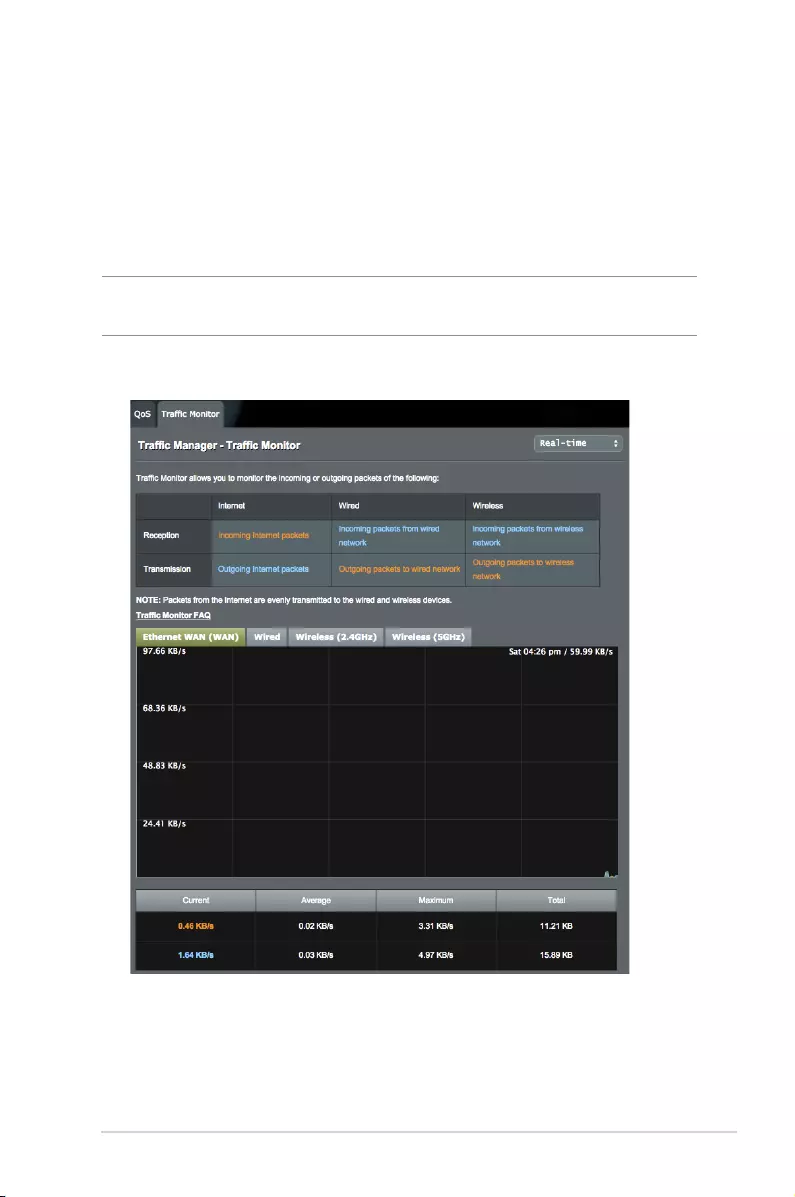
65
4.4.2 Traffic Monitor
The traffic monitor function allows you to access the bandwidth
usage and speed of your Ethernet WAN, Mobile broadband, wired,
and wireless networks. It allows you to monitor network traffic
even on a daily basis.
NOTE: Packets from the Ethernet WAN and Mobile broadband are
evenly transmitted to the wired and wireless devices.
Ethernet WAN traffic

66
Mobile Broadband traffic

67
4.4.3 Setting up Parental Controls
Parental Control allows you to control the Internet access time.
Users can set the time limit for a client’s network usage.
To use the parental control function:
1. From the navigation panel, go to General > Parental control.
2. Click ON to enable Parental Control.
3. Select the client whose network usage you want to control.
You may also key in the client’s MAC address in the Client
MAC Address column.
NOTE: Ensure that the client name does not contain special characters
or spaces as this may cause the router to function abnormally.
4. Click Add or Delete to add or delete the client’s profile.
5. Set up the allowed time limit in Time Management map.

68
6. Drag and drop a desired time zone to allow client’s network
usage.
6. Click OK.
7. Click Apply to save the settings.

69
4.5 Firewall
The wireless router can serve as a hardware firewall for your
network.
NOTE: The Firewall feature is enabled by default.
4.5.1 General
To set up basic Firewall settings:
1. From the navigation panel, go to Advanced Settings >
Firewall > General tab.
2. On the Enable Firewall field, select Yes.
3. On the Enable DoS protection, select Ye s to protect your
network from DoS (Denial of Service) attacks though this may
affect your router’s performance.
4. You can also monitor packets exchanged between the LAN
and WAN connection. On the Logged packets type, select
Dropped, Accepted, or Both.
5. Click Apply.
4.5.2 URL Filter
You can specify keywords or web addresses to prevent access to
specific URLs.
NOTE: The URL Filter is based on a DNS query. If a network client has
already accessed a website such as http://www.abcxxx.com, then the
website will not be blocked (a DNS cache in the system stores previously
visited websites). To resolve this issue, clear the DNS cache before
setting up the URL Filter.

70
To set up a URL filter:
1. From the navigation panel, go to Advanced Settings >
Firewall > URL Filter tab.
2. On the Enable URL Filter field, select Enabled.
3. Enter a URL and click the button.
4. Click Apply.
4.5.3 Keyword filter
Keyword filter blocks access to webpages containing specified
keywords.To set up a keyword filter:
1. From the navigation panel, go to Advanced Settings >
Firewall > Keyword Filter tab.
2. On the Enable Keyword Filter field, select Enabled.
3. Enter a word or phrase and click the Add button.
4. Click Apply.
NOTES:
• The Keyword Filter is based on a DNS query. If a network client has
already accessed a website such as http://www.abcxxx.com, then
the website will not be blocked (a DNS cache in the system stores
previously visited websites). To resolve this issue, clear the DNS cache
before setting up the Keyword Filter.
• Web pages compressed using HTTP compression cannot be filtered.
HTTPS pages also cannot be blocked using a keyword filter.
4.5.4 Network Services Filter
The Network Services Filter blocks LAN to WAN packet exchanges
and restricts network clients from accessing specific web services
such as Telnet or FTP.

71
To set up a Network Service filter:
1. From the navigation panel, go to Advanced Settings >
Firewall > Network Service Filter tab.
2. On the Enable Network Services Filter field, select Ye s.
3. Select the Filter table type. Black List blocks the specified
network services. White List limits access to only the specified
network services.
4. Specify the day and time when the filters will be active.
5. To specify a Network Service to filter, enter the Source IP,
Destination IP, Port Range, and Protocol. Click the button.
6. Click Apply.
4.5.5 IPv6 Firewall
By default, your ASUS wireless router blocks all unsolicited
incoming traffic. The IPv6 Firewall function allows incoming traffic
coming from specified services to go through your network.

72
4.6 Using the USB Application
The USB Applications function provides AiDisk, Servers Center,
Network Printer Server and Download Master submenus.
IMPORTANT! To use the server functions, you need to insert a USB
storage device, such as a USB hard disk or USB flash drive, in the USB
2.0 port on the rear panel of your wireless router. Ensure that the USB
storage device is formatted and partitioned properly. Refer to the ASUS
website at http://event.asus.com/2009/networks/disksupport/ for the
file system support table.
4.6.1 Using AiDisk
AiDisk allows you to share files stored on a connected USB device
through the Internet. AiDisk also assists you with setting up ASUS
DDNS and an FTP server.
To use AiDisk:
1. From the navigation panel, go to General > USB application,
then click the AiDisk icon.
2. From the Welcome to AiDisk wizard screen, click Go.

73
3. Select the access rights that you want to assign to the clients
accessing your shared data.
4. Create your domain name via the ASUS DDNS services, read
the Terms of Service and then select I will use the service
and accept the Terms of service and key in your domain
name. When done, click Next.

74
You can also select Skip ASUS DDNS settings then click Next
to skip the DDNS setting.
You can also select Skip ASUS DDNS settings then click Next
to skip the DDNS setting.
5. Click Finish to complete the setting.
6. To access the FTP site that you created, launch a web browser
or a third-party FTP client utility and key in the ftp link
(ftp://<domain name>.asuscomm.com) you have previously
created.

75
4.6.2 Using Servers Center
Servers Center allows you to share the media files from the USB
disk via a Media Server directory, Samba share service, or FTP
share service. You can also configure other settings for the USB
disk in the Servers Center.
Using Media Server
Your wireless router allows DLNA-supported devices to access
multimedia files from the USB disk connected to your wireless
router.
NOTE: Before using the DLNA Media Server function, connect your
device to the 4G-AC55U’s network.

76
To launch the Media Server setting page, go to General > USB
application > Media Services and Servers > Media Servers tab.
Refer to the following for the descriptions of the fields:
• Enable iTunes Server: Select ON/OFF to enable/disable the
iTunes Server.
• Enable DLNA Media Server: Select ON/OFF to enable/
disable the DLNA Media Server.
• Media Server Status: Displays the status of the media server.
• Media Server Path Setting: Select All Disks Shared or
Manual Media Server Path.
4.6.3 Using Network Place (Samba) Share service
Network Place (Samba) Share allows you to set up the accounts
and permissions for the Samba service.
To use Samba share:
1. From the navigation panel, go to General > USB application
> Media Services and Servers > Network Place (Samba)
Share / Cloud Disk tab.
NOTE: Network Place (Samba) Share is enabled by default.

77
To delete an existing account:
a) Select the account that you want to delete.
b) Click .
c) When prompted, click Delete to confirm the account
deletion.
To add a folder:
a) Click .
b) Enter the folder name, and click Add. The folder that you
created will be added to the folder list.
2. Follow the steps below to add, delete, or modify an
account.
To create a new account:
a) Click to add new account.
b) In the Account and Password fields, key in the name and
password of your network client. Retype the password to
confirm. Click Add to add the account to the list.

78
3. From the list of folders, select the type of access permission
that you want to assign for specific folders:
• R/W: Select this option to assign read/write access.
• R: Select this option to assign read-only access.
• No: Select this option if you do not want to share a specific
file folder.
4. Click Apply to apply the changes.
4.6.4 Using the FTP Share service
FTP share enables an FTP server to share files from USB disk to
other devices via your local area network or via the Internet.
IMPORTANT:
• EnsurethatyousafelyremovetheUSBdisk.Incorrectremovalofthe
USB disk may cause data corruption.
• TosafelyremovetheUSBdisk,refertothesectionSafely removing
the USB disk under 3.1.5 Monitoring your USB device.

79
To use FTP Share service:
NOTE: Ensure that you have set up your FTP server through
AiDisk. For more details, refer to the section “4.6.1 Using AiDisk”.
1. From the navigation panel, click General > USB application
> Media Services and Servers > FTP Share tab.
2. From the list of folders, select the type of access rights that
you want to assign for specific folders:
• R/W: Select to assign read/write access for a specific folder.
• W: Select to assign write only access for a specific folder.
• R: Select to assign read only access for a specific folder.
• No: Select this option if you do not want to share a specific
folder.
3. If you prefer, you can set the Allow anonymous login field to
ON.
4. In the Maximum number of concurrent connections field,
key in the number of devices that can simultaneously connect
to the FTP share server.
5. Click Apply to confirm the changes.
6. To access the FTP server, key in the ftp link
ftp://<hostname>.asuscomm.com and your user name and
password on a web browser or a third-party FTP utility.

80
4.7 Download Master
Download Master is a utility that helps you download files even
while your laptops or other devices are switched off.
NOTE: You need a USB device connected to the wireless router to use
Download Master.
To use Download Master:
1. Click General > USB application > Download Master to
download and install the utility automatically.
NOTE: If you have more than one USB drive, select the USB device you
want to download the files to.
2. After the download process is finished, click the Download
Master icon to start using the utility.
3. Click Add to add a download task.

81
4. Select a download type such as BitTorrent, HTTP, or FTP.
Provide a torrent file or a URL to begin downloading.
NOTE: For details on Bit Torrent, refer to section “4.7.1 Configuring Bit
Torrent download settings”.
5. Use the navigation panel to configure the General settings.
• YoucandenethedownloadschedulebySelecting
download Immediately or At Schedule Time.
• Thedownloadtasksinformationupdateseach5secondsin
default. The options, Refresh rate, allow you to change the
information updated period.
• YoucanselectfolderpathfromDownload to field as
download file repository.
• ThedefaultportnumberforDownloadMaster
administration page is 8081. If the port number conflicts with
other application you can change from here.
• TomanagetheDownloadMaster from Internet, you can
slide WAN network to ON.
• Ifyournetworkresourceistight,werecommendyoudisable
Keep seeding after task completed by sliding the witch to
OFF.

82
4.7.1 Configuring Bit Torrent download settings
To configure BitTorrent download settings:
1. From Download Master’s navigation panel, click Bit Torrent to
launch the Bit Torrent Setting page.
2. Select a specific port or use the default port for your
download task.
3. To prevent network congestion, you can limit the maximum
upload and download speeds under Speed Limits.
4. You can limit the maximum number of allowed peers and
enable or disable file encryption during downloads.
5. Enable DHT (Distributed Hash Table) network can enhance
download speeds and transfer rates by jointing a information
sharing domain. To use the DHT network, your wireless router
also needs to share some information with other member on
the network,
6. Enable PEX (Peer Exchange) network to exchange peer
information between two connected peers help you to gather
more peers in the network.

83
4.7.2 NZB settings
You can set up a USENET server to download NZB files. After
entering USENET settings, click Apply.
4.7.3 eMule settings
You can set up a eMule server to download file from eMule. After
entering USENET settings, click Apply.

84
4.8 Using AiCloud 2.0
AiCloud 2.0 is a cloud service application that allows you to save,
sync, share, and access your files.
To use AiCloud:
1. From Google Play Store or Apple Store, download and install
the ASUS AiCloud app to your smart device.
2. Connect your smart device to your network. Follow the
instructions to complete the AiCloud setup process.
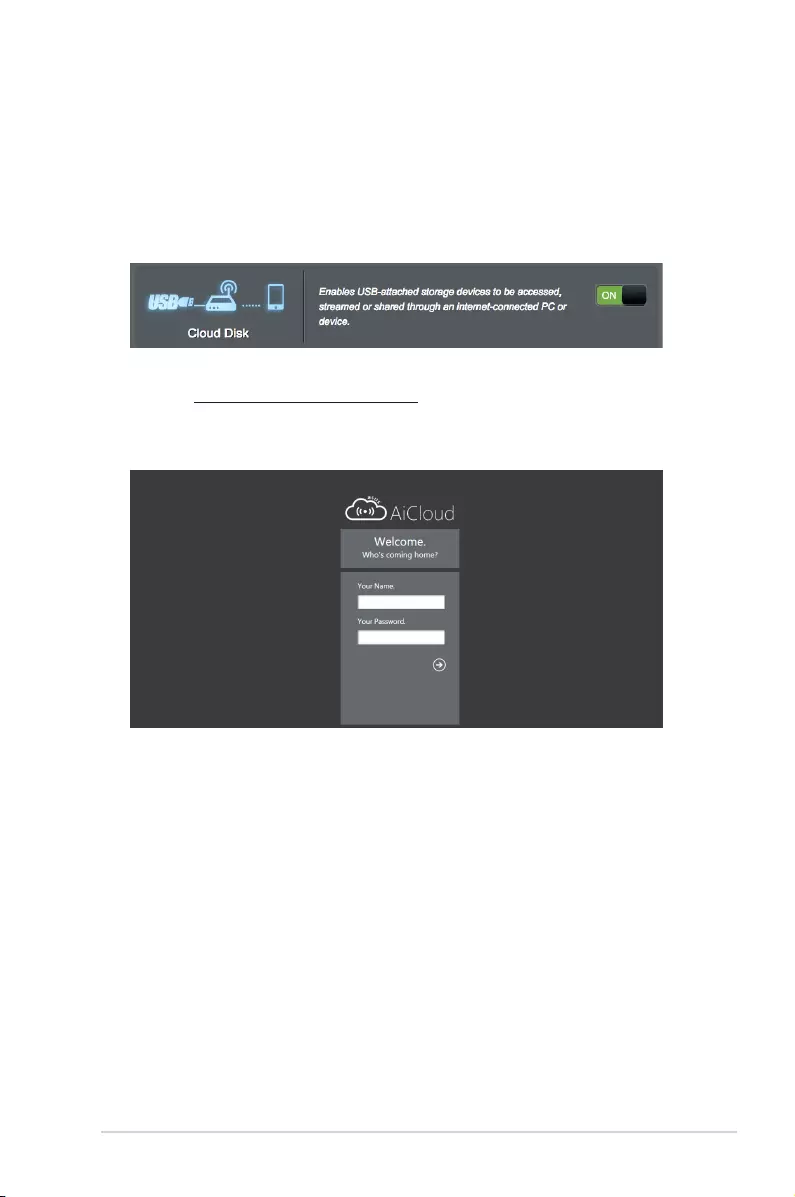
85
4.8.1 Cloud Disk
To create a cloud disk:
1. Insert a USB storage device into the wireless router.
2. Turn on Cloud Disk.
3. Go to https://router.asus.com and enter the router login
account and password. For better user experience, we
recommend that you use Google Chrome or Firefox.

86
4. You can now start accessing Cloud Disk files on devices
connected to the network.
NOTE: When accessing the devices that are connected to the network,
you need to enter the device’s user name and password manually, which
will not be saved by AiCloud for security reason.
4.8.2 Smart Access
The Smart Access function allows you to easily access your home
network via your router’s domain name.
NOTES:
• YoucancreateadomainnameforyourrouterwithASUSDDNS.For
more details, refer to section 4.3.7 DDNS.
• Bydefault,AiCloudprovidesasecureHTTPSconnection.Keyin
https://[yourASUSDDNSname].asuscomm.com for a very secure
Cloud Disk and Smart Access usage.
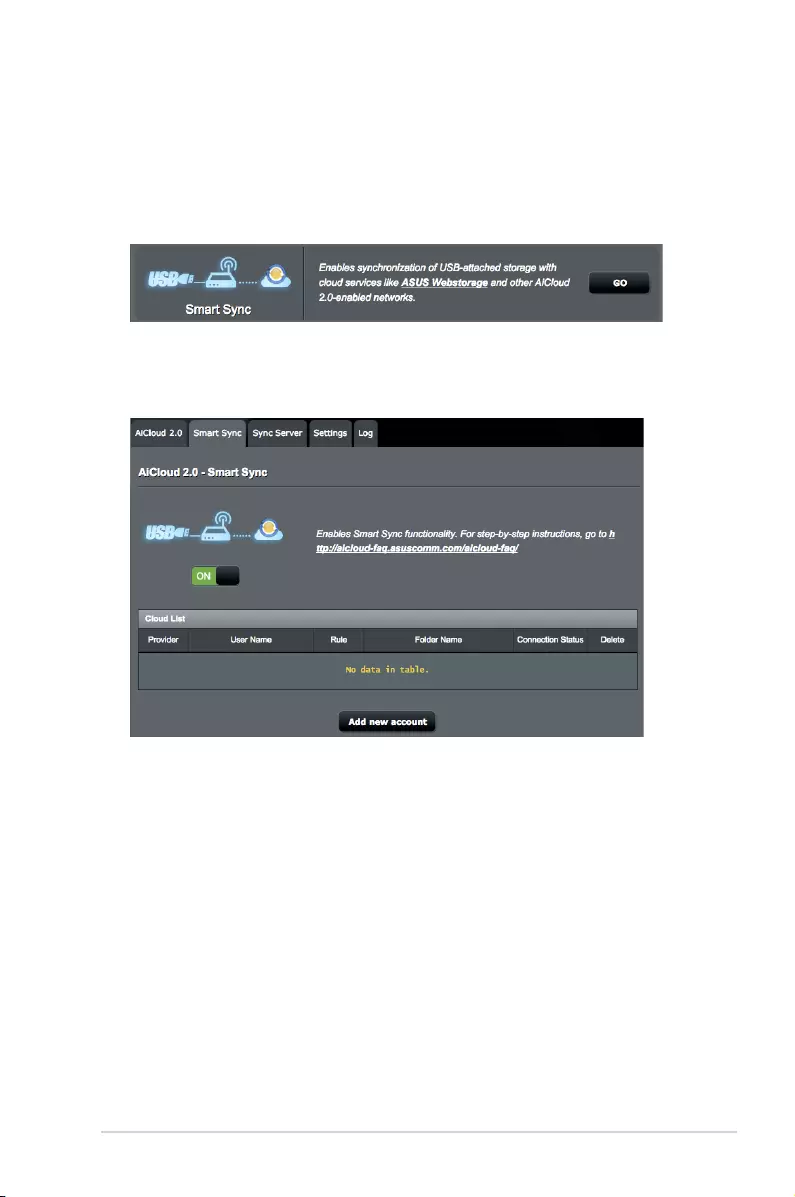
87
4.8.3 Smart Sync
To use Smart Sync:
1. From the nabigation panel, click AiCloud 2.0 > AiCloud 2.0
>Smart Sync > Go.
2. Select ON to enable Smart Sync.
3. Click Add new account.
4. Enter your ASUS WebStorage or Dropbox account password
and select the directory that you want to sync with
WebStorage.
5. Select Syn rules for the Smart sync task.
• Synchronization: Selecting Synchronization allows you to
sync a folder between two servers, which sync task always
keeps your folder with the same files.
• Download to USB Disk: Selecting Download to USB Disk
allows you to replicate the remote files to the local folder on
USB Disk.
• Upload to Cloud: Selecting Upload to Cloud allows you
to replicate the local files to the remote folder on ASUS
WebStorage.

88
6. Click Apply to add the sync task .
4.8.4 Sync Server
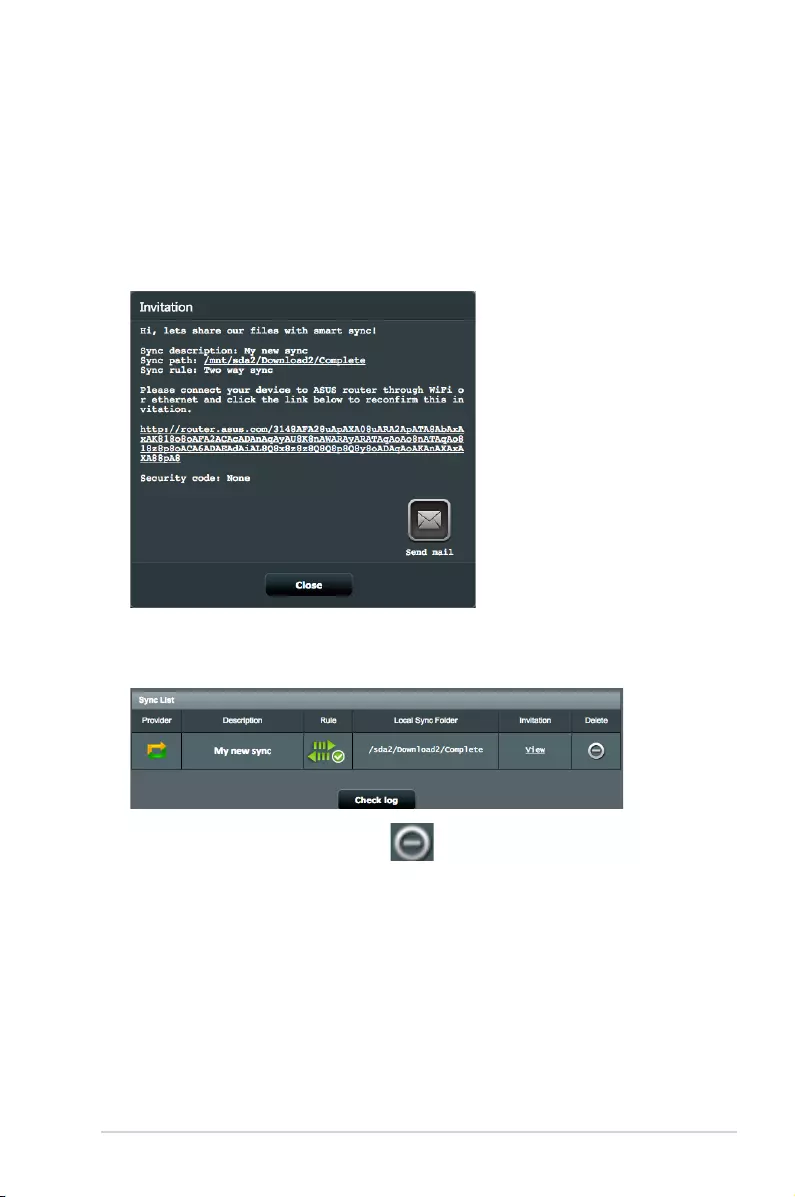
89
To use Sync Server:
1. From the navigation panel, click AiCloud 2.0 > Sync Server.
2. Enter Sync Server configuration on Invitation Generator to
enable Smart Sync.
3. Send your friend the sync invitation.
4. After a invitation is generated, you can check the sync task on
Sync List table .
5. You can click Delete button to terminate the task if
you don’t want sync task the folder with remote sync client
anymore.
6. You can also check the activities of sync server by clicking
Check log button or lick Log tab.

90

91
4.8.5 Settings
AiCloud 2.0 allows you to define a access policy to prevent
unauthorized access, such as dictionary attack. When a host try to
access the AiCloud and exceed the defined Maximum number of
failed login attempts in the defined duration, the AiCloud service
will be disabled automatically.
The Secure Socket Layer (SSL) is a protocol that provide an
encrypted communication between web server and browsers for
secure data transfer, which includes access password. User access
the AiCloud web portal use a default port, 443, over https. The
content delivering uses a default port, 8082, over http.

92
4.9 Administration
4.9.1 Operation Mode
The Operation Mode page allows you to select the appropriate
mode for your network.
To set up the operating mode:
1. From the navigation panel, go to Advanced Settings >
Administration > Operation Mode tab.
2. Select any of these operation modes:
• Wireless router mode (default): In wireless router mode,
the wireless router connects to the Internet and provides
Internet access to available devices on its own local network.
• Repeater Mode: In Repeater mode, your wireless router
wirelessly connects to an existing wireless network to
extend the wireless coverage. In this mode, the firewall, IP
sharing, and NAT functions are disabled.
• Access Point mode: In this mode, the router creates a
new wireless network on an existing network.
• Media Bridge: This setup requires two wireless routers.
The second router serves as a media bridge where
multiple devices such as Smart TVs and gaming consoles
can be connected via Ethernet.

93
3. Click Apply.
NOTE: The router will reboot when you change the modes.
4.9.2 System
The System page allows you to configure your wireless router
settings.

94
To set up the System settings:
1. From the navigation panel, go to Advanced Settings >
Administration > System tab.
2. You can configure the following settings:
• Change router login password: You can change the
password and login name for the wireless router by entering
a new name and password.
• Time Zone: Select the time zone for your network.
• NTP Server: The wireless router can access a NTP (Network
time Protocol) server in order to synchronize the time.
• Enable Telnet: Click Yes to enable Telnet services on the
network. Click No to disable Telnet.
• Authentication Method: You can select HTTP, HTTPS, or
both protocols to secure router access.
• Enable Web Access from WAN: Select Yes to allow devices
outside the network to access the wireless router GUI
settings. Select No to prevent access.
• Auto Logout: System will auto log out the administration
page after an idle period. To disable Auto logout, set the
value in 0.
• Enable WAN down browser redirect notice: When WAN
connection is down, the system will pop up a screen to guide
to how to configure the WAN connection. If you don’t like to
see this notice, select No to disable the notice.
• Allow only specified IP address: Click Yes if you want to
specify the IP addresses of devices that are allowed access to
the wireless router GUI settings from WAN.
• Specified IP Address: Enter the WAN IP addresses of
networking devices allowed to access the wireless router
settings. This Client list allows you to add the maximum IP
addresses of 4.
3. Click Apply.

95
4.9.3 Firmware Upgrade
NOTE: Download the latest firmware from the ASUS website at
http://www.asus.com
To upgrade the firmware:
1. From the navigation panel, go to Advanced Settings >
Administration > Firmware Upgrade tab.
2. In the New Firmware File field, click Browse to locate the
downloaded file.
3. Click Upload.
NOTES:
• Whentheupgradeprocessiscomplete,waitforsometimeforthe
system to reboot.
• Iftheupgradeprocessfails,thewirelessrouterautomaticallyenters
rescue mode and the power LED indicator on the front panel starts
flashing slowly. To recover or restore the system, refer to section "5.2
Firmware Restoration".

96
4.9.4 Restore/Save/Upload Setting
To restore/save/upload wireless router settings:
1. From the navigation panel, go to Advanced Settings >
Administration > Restore/Save/Upload Setting tab.
2. Select the tasks that you want to do:
• Torestoretothedefaultfactorysettings,clickRestore, and
click OK in the confirmation message.
• Tosavethecurrentsystemsettings,clickSave, navigate to
the folder where you intend to save the file and click Save.
• Torestorefromasavedsystemsettingsle,clickBrowse to
locate your file, then click Upload.
Note: If issues occur, upload the latest firmware version and configure
new settings. Do not restore the router to its default settings.

97
4.10 System Log
System Log contains your recorded network activities.
NOTE: System log resets when the router is rebooted or powered off.
To view your system log:
1. From the navigation panel, go to Advanced Settings >
System Log.
2. You can view your network activities in any of these tabs:
• GeneralLog
• WirelessLog
• DHCPLeases
• IPv6(WANandLANnetworkinformation)
• WirelessLog
• PortForwarding
• RoutingTable
• Connection

98
4.11 Ethernet WAN Mobile Broadband
Function Support List
Wired WAN LAN as WAN Mobile
broadband
LAN
IPTV V N/A N/A
Switch Control >>
NAT Acceleration(IPv4
Only)
V N/A N/A
Switch Control >>
Jumbo Frame
V N/A N/A
WAN
IPv6 V V V (1)
Port Trigger V V V (2)
Virtual Server / Port
Forwarding V V V (2)
DMZ V V V (2)
DDNS V V V (2)
NAT Passthrough V V V (2)
Traffic Manager
QoS V V V
Firewall
General V V V
URL Filter V V V
Keyword Filter V V V
Network Services Filter V V V
IPv6 Firewall V V N/A
Administration
System >>
Enable Web Access from
WAN
V V V (2)
The wireless router supports wired WAN and Mobile broadband
WAN in failover and failback modes. The Mobile broadband WAN
is used both as Internet access and WAN backup interface. LAN,
WAN, VPN, and Firewall supports different functions. See the
comparison table below.

99
NOTES:
V (1) : Mobile WAN has separated configuration on its configuration page
V (2) : In most of using case, Internet service provide dispatch the mobile
broadband a private IP, that will cause the WAN service failed to
access from WAN side.
Applications
AiCloud
Access from WAN
V V V (2)
VPN Server V V V (2)
FTP Server V V V (2)

100
5 Utilities
NOTES:
• Downloadandinstallthewirelessrouter'sutilitiesfromtheASUS
website:
• DeviceDiscoveryv1.4.7.1athttp://dlcdnet.asus.com/pub/ASUS/
LiveUpdate/Release/Wireless/Discovery.zip
• FirmwareRestorationv1.9.0.4athttp://dlcdnet.asus.com/pub/
ASUS/LiveUpdate/Release/Wireless/Rescue.zip
• WindowsPrinterUtilityv1.0.5.5athttp://dlcdnet.asus.com/pub/
ASUS/LiveUpdate/Release/Wireless/Printer.zip
• TheutilitiesarenotsupportedonMACOS.
5.1 Device Discovery
Device Discovery is an ASUS WLAN utility that detects an ASUS
wireless router device, and allows you to configure the wireless
networking settings.
To launch the Device Discovery utility:
• Fromyourcomputer’sdesktop,click
Start > All Programs > ASUS Utility > 4G-AC55U Wireless
Router > Device Discovery.
NOTE: When you set the router to Access Point mode, you need to use
Device Discovery to get the router’s IP address.

101
5.2 Firmware Restoration
Firmware Restoration is used on an ASUS Wireless Router that
failed during its firmware upgrading process. It uploads the
firmware that you specify. The process takes about three to four
minutes.
IMPORTANT: Launch the rescue mode on the router before using the
Firmware Restoration utility.
NOTE: This feature is not supported on MAC OS.
To launch the rescue mode and use the Firmware Restoration
utility:
1. Unplug the wireless router from the power source.
2. Hold the Reset button at the rear panel and simultaneously
replug the wireless router into the power source. Release the
Reset button when the Power LED at the front panel flashes
slowly, which indicates that the wireless router is in the rescue
mode.

102
3. Set a static IP on your computer and use the following to set
up your TCP/IP settings:
IP address: 192.168.1.x
Subnet mask: 255.255.255.0
4. From your computer’s desktop, click
Start > All Programs > ASUS Utility 4G-AC55U Wireless
Router > Firmware Restoration.
5. Specify a firmware file, then click Upload.
NOTE: This is not a firmware upgrade utility and cannot be used on
a working ASUS Wireless Router. Normal firmware upgrades must be
done through the web interface. Refer to Chapter 4: Configuring the
Advanced Settings for more details.
5.3 Setting up your printer server
5.3.1 ASUS EZ Printer Sharing
ASUS EZ Printing Sharing utility allows you to connect a USB
printer to your wireless router’s USB port and set up the print
server. This allows your network clients to print and scan files
wirelessly.

103
To set up the EZ Printer sharing mode:
1. From the navigation panel, go to General > USB Application
> Network Printer Server.
2. Click Download Now! to download the network printer
utility.
NOTE: Network printer utility is supported on Windows® XP, Windows®
Vista, and Windows® 7 only. To install the utility on Mac OS, select Use
LPR protocol for sharing printer.
3. Unzip the downloaded file and click the Printer icon to run the
network printer setup program.

104
4. Follow the onscreen instructions to set up your hardware,
then click Next.
5. Wait a few minutes for the initial setup to finish. Click Next.
6. Click Finish to complete the installation.

105
8. After the printer’s driver installation is complete, network
clients can now use the printer.
7. Follow the Windows® OS instructions to install the printer
driver.
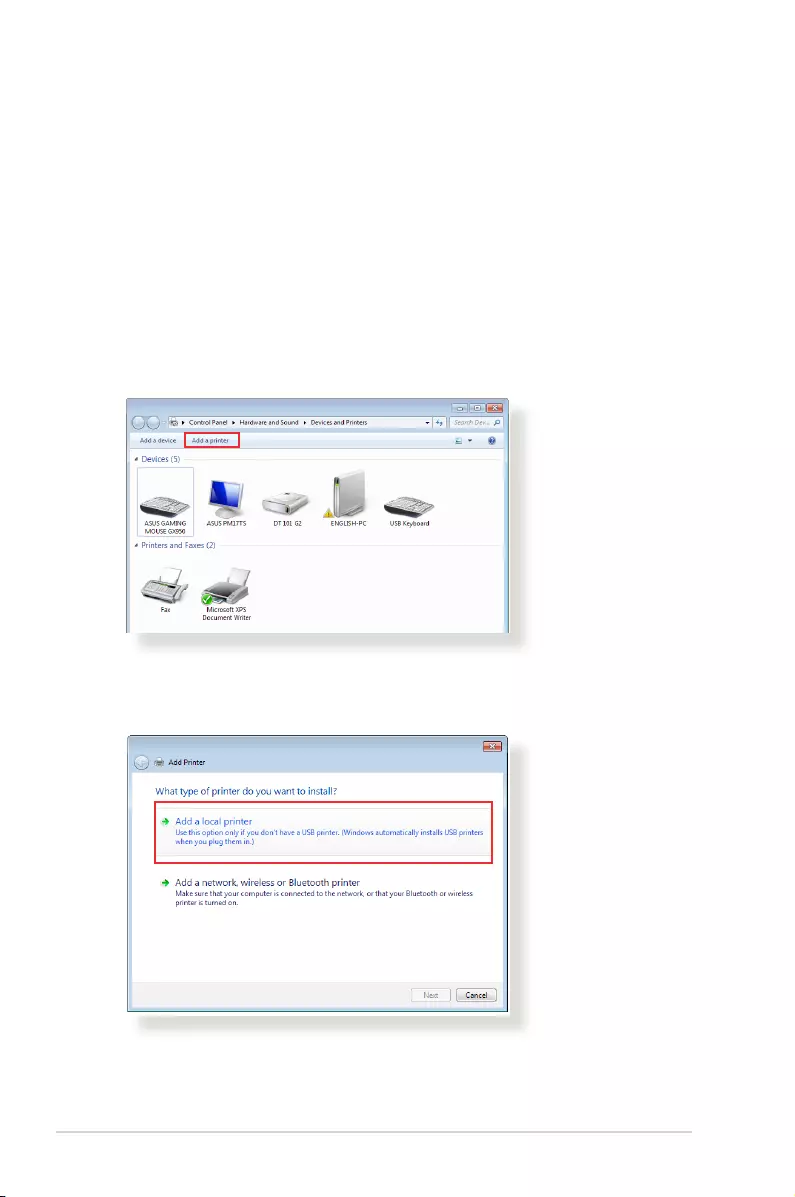
106
5.3.2 Using LPR to Share Printer
You can share your printer with computers running on Windows®
and MAC operating system using LPR/LPD (Line Printer Remote/
Line Printer Daemon).
Sharing your LPR printer
To share your LPR printer:
1. From the Windows® desktop, click Start > Devices and
Printers > Add a printer to run the Add Printer Wizard.
2. Select Add a local printer and then click Next.

107
3. Select Create a new port then set Type of Port to Standard
TCP/IP Port. Click New Port.
4. In the Hostname or IP address field, key in the IP address of
the wireless router then click Next.

108
5. Select Custom then click Settings.
6. Set Protocol to LPR. In the Queue Name field, key in
LPRServer then click OK to continue.

109
7. Click Next to finish setting up the standard TCP/IP port.
8. Install the printer driver from the vendor-model list. If your
printer is not in the list, click Have Disk to manually install the
printer drivers from a CD-ROM or file.

110
9. Click Next to accept the default name for the printer.
10. Click Finish to complete the installation.

111
6 Troubleshooting
This chapter provides solutions for issues you may encounter with
your router. If you encounter problems that are not mentioned
in this chapter, visit the ASUS support site at: http://support.asus.
com/ for more product information and contact details of ASUS
Technical Support.
6.1 Basic Troubleshooting
If you are having problems with your router, try these basic steps
in this section before looking for further solutions.
Upgrade Firmware to the latest version.
1. Launch the Web GUI. Go to Advanced Settings >
Administration > Firmware Upgrade tab. Click Check to
verify if the latest firmware is available.
2. If the latest firmware is available, visit the ASUS global
website at http://www.asus.com/Networks/Wireless_
Routers/4GAC55U/#download to download the latest
firmware.
3. From the Firmware Upgrade page, click Browse to locate the
firmware file.
4. Click Upload to upgrade the firmware.
Restart your network in the following sequence:
1. Turn off the modem.
2. Unplug the modem.
3. Turn off the router and computers.
4. Plug in the modem.
5. Turn on the modem and then wait for 2 minutes.
6. Turn on the router and then wait for 2 minutes.
7. Turn on computers.

112
Check if your Ethernet cables are plugged properly.
• WhentheEthernetcableconnectingtherouterwiththe
modem is plugged in properly, the WAN LED will be on.
• WhentheEthernetcableconnectingyourpowered-on
computer with the router is plugged in properly, the
corresponding LAN LED will be on.
Check if the wireless setting on your computer matches that
of your computer.
• Whenyouconnectyourcomputertotherouterwirelessly,
ensure that the SSID (wireless network name), encryption
mehtod, and password are correct.
Check if your network settings are correct.
• EachclientonthenetworkshouldhaveavalidIPaddress.
ASUS recommends that you use the wireless router’s DHCP
server to assign IP addresses to computers on your network.
• Somecablemodemserviceprovidersrequireyoutouse
the MAC address of the computer initially registered on
the account. You can view the MAC address in the web GUI,
Network Map > Clients page, and hover the mouse pointer
over your device in Client Status.

113
6.2 Frequently Asked Questions (FAQs)
I cannot access the router GUI using a web browser
• Ifyourcomputeriswired,checktheEthernetcable
connection and LED status as described in the previous
section.
• Ensurethatyouareusingthecorrectlogininformation.The
default factory login name and password is “admin/admin”.
Ensure that the Caps Lock key is disabled when you enter the
login information.
• Deletethecookiesandlesin
your web browser. For Internet
Explorer 8, follow these steps:
1. Launch Internet Explorer 8,
then click Tools > Internet
Options.
2. In the General tab,
under Browsing history,
click Delete…, select
Temporary Internet Files
and Cookies then click
Delete.
NOTES:
• Thecommandsfordeletingcookiesandfilesvarywithweb
browsers.
• Disableproxyserversettings,cancelthedial-upconnection,
and set the TCP/IP settings to obtain IP addresses
automatically. For more details, refer to Chapter 1 of this user
manual.
• EnsurethatyouuseCAT5eorCAT6ethernetcables.

114
The client cannot establish a wireless connection with the
router.
NOTE: If you are having issues connecting to 5Ghz network, make
sure that your wireless device supports 5Ghz or features dual band
capabilities.
• OutofRange:
• Movetherouterclosertothewirelessclient.
• Trytoadjustantennasoftheroutertothebestdirection
as described in section 1.4 Positioning your router.
• DHCPserverhasbeendisabled:
1. Launch the web GUI. Go to General > Network Map>
Clients and search for the device that you want to
connect to the router.
2. If you cannot find the device in the Network Map, go to
Advanced Settings > LAN > DHCP Server, Basic Config
list, select Ye s on the Enable the DHCP Server.
• SSIDhasbeenhidden.IfyourdevicecanndSSIDsfromother
routers but cannot find your router’s SSID, go to Advanced
Settings > Wireless > General, select No on Hide SSID, and
select Auto on Control Channel.
• IfyouareusingawirelessLANadapter,checkifthewireless
channel in use conforms to the channels available in your
country/area. If not, adjust the channel, channel bandwidth,
and wireless mode.
• Ifyoustillcannotconnecttotherouterwirelessly,youcan
reset your router to factory default settings. In the router
GUI,click Administration > Restore/Save/Upload Setting
and click Restore.

115
Wired Internet is not accessible.
• CheckifyourroutercanconnecttoyourISP’sWANIPaddress.
To do this, launch the web GUI and go to General> Network
Map, and check the Internet Status.
• IfyourroutercannotconnecttoyourISP’sWANIPaddress,
try restarting your network as described in the section
Restart your network in following sequence under Basic
Troubleshooting.
• ThedevicehasbeenblockedviatheParentalControl
function. Go to General > Parental Control and see if the
device is in the list. If the device is listed under Client Name,
remove the device using the Delete button or adjust the Time
Management Settings.
• IfthereisstillnoInternetaccess,trytorebootyourcomputer
and verify the network’s IP address and gateway address.
• CheckthestatusindicatorsontheADSLmodemandthe
wireless router. If the WAN LED on the wireless router is not
ON, check if all cables are plugged properly.
Mobile broadband Internet is not accessible.
• InsertaSIMthatwithdataplansubscriptionintotheUSIM
card slot. The 3G/4G Mobile Broadband LED lights up,
indicating that the SIM card is properly installed.
• TheAPNsettingsarenotappliedautomatically.Obtainthe
APN service settings from your ISP, then follow the steps
below tho manually configure the APN settings.
• GotoAdvanced Settings > WAN > Internet Connection
tab.
• IntheWAN Type field, select Mobile broadband.
• IfAPNisconguredcorrectandInternetconnectionstill
failed, ensure that:
• ThefrequencybandiscompatiblewithyourISP.

116
• Thewirelessrouterisplacedclosetothewindowfora
strong 3G/4G signal.
• Porttrigger,portforwarding,DDNSorDMZservicecannot
work. Most ISPs provide a private IP address for a mobile
broadband device. Hence some services, such as AiCloud, are
not accessible. Please contact your ISP for assistance.
You forgot the SSID (network name) or network password
• SetupanewSSIDandencryptionkeyviaawiredconnection
(Ethernet cable). Launch the web GUI, go to Network Map,
click the router icon, enter a new SSID and encryption key,
and then click Apply.
• Resetyourroutertothedefaultsettings.LaunchthewebGUI,
go to Administration > Restore/Save/Upload Setting, and
click Restore. The default login account and password are
both “admin”.

117
How to restore the system to its default settings?
• GotoAdministration > Restore/Save/Upload Setting, and
click Restore.
The following are the factory default settings:
User Name: admin
Password: admin
Enable DHCP: Yes (if WAN cable is plugged in)
IP address: 192.168.1.1
Domain Name: (Blank)
Subnet Mask: 255.255.255.0
DNS Server 1: 192.168.1.1
DNS Server 2: (Blank)
SSID (2.4GHz): ASUS
SSID (5GHz): ASUS_5G
Firmware upgrade failed.
Launch the rescue mode and run the Firmware Restoration utility.
Refer to section 5.2 Firmware Restoration on how to use the
Firmware Restoration utility.

118
Cannot access Web GUI
A. Disable the proxy server, if enabled.
Windows® 7
1. Click Start > Internet
Explorer to launch the
browser.
2. Click Tools > Internet options
> Connections tab > LAN
settings.
Before configuring your wireless router, do the steps described in
this section for your host computer and network clients.
3. From the Local Area
Network (LAN) Settings
screen, untick Use a
proxy server for your
LAN.
4. Click OK when done.

119
MAC OS
1. From your Safari
browser, click Safari
> Preferences >
Advanced > Change
Settings...
2. From the Network
screen, deselect FTP
Proxy and Web Proxy
(HTTP).
3. Cllick Apply Now when
done.
NOTE:Refertoyourbrowser'shelpfeaturefordetailsondisablingthe
proxy server.
B. Set the TCP/IP settings to automatically obtain an IP
address.
Windows® 7
1. Click Start > Control Panel
> Network and Internet
> Network and Sharing
Center > Manage network
connections.
2. Select Internet Protocol
Version 4 (TCP/IPv4) or
Internet Protocol Version
6 (TCP/IPv6), then click
Properties.

120
3. To obtain the IPv4 IP
settings automatically,
tick Obtain an IP address
automatically.
To obtain the IPv6 IP
settings automatically, tick
Obtain an IPv6 address
automatically.
4. Click OK when done.
MAC OS
1. Click the Apple icon
located on the top left
of your screen.
2. Click System
Preferences > Network
> Configure...
3. From the TCP/IP tab,
select Using DHCP in
the Configure IPv4
dropdown list.
4. Cllick Apply Now when
done.
NOTE: Refer to your operating system’s help and support feature for
details on configuring your computer’s TCP/IP settings.

121
C. Disable the dial-up connection, if enabled.
Windows® 7
1. Click Start > Internet Explorer
to launch the browser.
2. Click Tools > Internet options
> Connections tab.
3. Tick Never dial a connection.
4. Click OK when done.
NOTE:Refertoyourbrowser'shelpfeaturefordetailsondisablingthe
dial-up connection.

122
Appendices
Notices
ASUS Recycling/Takeback Services
ASUS recycling and takeback programs come from our
commitment to the highest standards for protecting our
environment. We believe in providing solutions for you to be able
to responsibly recycle our products, batteries, other components,
as well as the packaging materials. Please go to http://csr.asus.
com/english/Takeback.htm for the detailed recycling information
in different regions.
REACH
Complying with the REACH (Registration, Evaluation,
Authorisation, and Restriction of Chemicals) regulatory
framework, we published the chemical substances in our products
at ASUS REACH website at
http://csr.asus.com/english/index.aspx
Federal Communications Commission Statement
This device complies with Part 15 of the FCC Rules. Operation is
subject to the following two conditions:
• Thisdevicemaynotcauseharmfulinterference.
• Thisdevicemustacceptanyinterferencereceived,including
interference that may cause undesired operation.
This equipment has been tested and found to comply with the
limits for a class B digital device, pursuant to part 15 of the FCC
Rules. These limits are designed to provide reasonable protection
against harmful interference in a residential installation.

123
This equipment generates, uses and can radiate radio frequency
energy and, if not installed and used in accordance with
the instructions, may cause harmful interference to radio
communications. However, there is no guarantee that interference
will not occur in a particular installation. If this equipment does
cause harmful interference to radio or television reception, which
can be determined by turning the equipment off and on, the user
is encouraged to try to correct the interference by one or more of
the following measures:
• Reorientorrelocatethereceivingantenna.
• Increasetheseparationbetweentheequipmentandreceiver.
• Connecttheequipmentintoanoutletonacircuitdierent
from that to which the receiver is connected.
• Consultthedealeroranexperiencedradio/TVtechnicianfor
help.
IMPORTANT! This device is going to be operated in 5.15~5.25GHz
frequency range, it is restricted in indoor environment only.
WARNING!
• Anychangesormodificationsnotexpresslyapprovedbytheparty
responsible for compliance could void the user’s authority to operate
the equipment.
• Usersmustnotmodifythisdevice.Modificationsbyanyoneother
than the party responsible for compliance with the rules of the
Federal Communications Commission (FCC) may void the authority
granted under FCC regulations to operate this device.
• ForproductavailableintheUSA/Canadamarket,onlychannel1~11
can be operated. Selection of other channels is not possible.

124
Declaration of Conformity for R&TTE directive 1999/5/EC
Essential requirements – Article 3
Protection requirements for health and safety – Article 3.1a
Testing for electric safety according to EN 60950-1 has been
conducted. These are considered relevant and sufficient.
Protection requirements for electromagnetic compatibility
– Article 3.1b
Testing for electromagnetic compatibility according to EN
301 489-1 and EN 301 489-17 has been conducted. These are
considered relevant and sufficient.
Effective use of the radio spectrum – Article 3.2
Testing for radio test suites according to EN 300 328 & EN 301
893 have been conducted. These are considered relevant and
sufficient.
Operate the device in 5150-5250 MHz frequency band for indoor
use only.
CE Mark Warning
This is a Class B product, in a domestic environment, this product
may cause radio interference, in which case the user may be
required to take adequate measures.
This equipment may be operated in AT, BE, CY, CZ, DK, EE, FI, FR,
DE, GR, HU, IE, IT, LU, MT, NL, PL, PT, SK, SL, ES, SE, GB, IS, LI, NO, CH,
BG, RO, RT.
Radio Frequency (RF) Exposure Information
This equipment complies with IC RSS-102 radiation exposure
limits set forth for an uncontrolled environment. This equipment
should be installed and operated with minimum distance 31 cm
between the radiator & your body.
Cet équipement est conforme aux limites d’exposition aux

125
rayonnements IC établies pour un environnement non contrôlé.
Cet équipement doit être installé et utilisé avec un minimum de
31 cm de distance entre la source de rayonnement et votre corps.
Canada, avis d’Industry Canada (IC)
Le présent appareil est conforme aux CNR d’Industrie Canada
applicables aux appareils radio exempts de licence. L’exploitation
est autorisée aux deux conditions suivantes : (1) l’appareil ne
doit pas produire de brouillage, et (2) l’utilisateur de l’appareil
doit accepter tout brouillage radioélectrique subi, même si le
brouillage est susceptible d’en compromettre le fonctionnement.

126

127
NCC 警語
經型式認證合格之低功率射頻電機,非經許可,公司、商號或
使用者均不得擅自變更頻率、加大功率或變更原設計之特性及
功能。低功率射頻電機之使用不得影響飛航安全及干擾合法通
信;經發現有干擾現象時,應立即停用,並改善至無干擾時方
得繼續使用。前項合法通信,指依電信法規定作業之無線電通
信。低功率射頻電機須忍受合法通信或工業、科學及醫療用電
波輻射性電機設備之干擾。
GNU General Public License
Licensing information
This product includes copyrighted third-party software licensed
under the terms of the GNU General Public License. Please see The
GNU General Public License for the exact terms and conditions
of this license. We include a copy of the GPL with every CD
shipped with our product. All future firmware updates will also be
accompanied with their respective source code. Please visit our
web site for updated information. Note that we do not offer direct
support for the distribution.
GNU GENERAL PUBLIC LICENSE
Version 2, June 1991
Copyright (C) 1989, 1991 Free Software Foundation, Inc.
59 Temple Place, Suite 330, Boston, MA 02111-1307 USA
Everyone is permitted to copy and distribute verbatim copies of
this license document, but changing it is not allowed.
Preamble
The licenses for most software are designed to take away your
freedom to share and change it. By contrast, the GNU General
Public License is intended to guarantee your freedom to share
and change free software--to make sure the software is free for all
its users. This General Public License applies to most of the Free

128
Software Foundation’s software and to any other program whose
authors commit to using it. (Some other Free Software Foundation
software is covered by the GNU Library General Public License
instead.) You can apply it to your programs, too.
When we speak of free software, we are referring to freedom, not
price. Our General Public Licenses are designed to make sure that
you have the freedom to distribute copies of free software (and
charge for this service if you wish), that you receive source code or
can get it if you want it, that you can change the software or use
pieces of it in new free programs; and that you know you can do
these things.
To protect your rights, we need to make restrictions that forbid
anyone to deny you these rights or to ask you to surrender the
rights. These restrictions translate to certain responsibilities for
you if you distribute copies of the software, or if you modify it.
For example, if you distribute copies of such a program, whether
gratis or for a fee, you must give the recipients all the rights that
you have. You must make sure that they, too, receive or can get
the source code. And you must show them these terms so they
know their rights.
We protect your rights with two steps: (1) copyright the software,
and (2) offer you this license which gives you legal permission to
copy, distribute and/or modify the software.
Also, for each author’s protection and ours, we want to make
certain that everyone understands that there is no warranty for
this free software. If the software is modified by someone else and
passed on, we want its recipients to know that what they have is
not the original, so that any problems introduced by others will
not reflect on the original authors’ reputations.
Finally, any free program is threatened constantly by software
patents. We wish to avoid the danger that redistributors of a free
program will individually obtain patent licenses, in effect making

129
the program proprietary. To prevent this, we have made it clear
that any patent must be licensed for everyone’s free use or not
licensed at all.
The precise terms and conditions for copying, distribution and
modification follow.
Terms & conditions for copying, distribution, & modification
0. This License applies to any program or other work which
contains a notice placed by the copyright holder saying it may
be distributed under the terms of this General Public License.
The “Program”, below, refers to any such program or work, and
a “work based on the Program” means either the Program or
any derivative work under copyright law: that is to say, a work
containing the Program or a portion of it, either verbatim or
with modifications and/or translated into another language.
(Hereinafter, translation is included without limitation in the
term “modification”.) Each licensee is addressed as “you”.
Activities other than copying, distribution and modification
are not covered by this License; they are outside its scope. The
act of running the Program is not restricted, and the output
from the Program is covered only if its contents constitute
a work based on the Program (independent of having been
made by running the Program). Whether that is true depends
on what the Program does.
1. You may copy and distribute verbatim copies of the Program’s
source code as you receive it, in any medium, provided that
you conspicuously and appropriately publish on each copy
an appropriate copyright notice and disclaimer of warranty;
keep intact all the notices that refer to this License and to the
absence of any warranty; and give any other recipients of the
Program a copy of this License along with the Program.
You may charge a fee for the physical act of transferring a
copy, and you may at your option offer warranty protection in
exchange for a fee.
2. You may modify your copy or copies of the Program or any
portion of it, thus forming a work based on the Program, and
copy and distribute such modifications or work under the

130
terms of Section 1 above, provided that you also meet all of
these conditions:
a) You must cause the modified files to carry prominent
notices stating that you changed the files and the date of any
change.
b) You must cause any work that you distribute or publish,
that in whole or in part contains or is derived from the
Program or any part thereof, to be licensed as a whole at no
charge to all third parties under the terms of this License.
c) If the modified program normally reads commands
interactively when run, you must cause it, when started
running for such interactive use in the most ordinary way, to
print or display an announcement including an appropriate
copyright notice and a notice that there is no warranty (or
else, saying that you provide a warranty) and that users may
redistribute the program under these conditions, and telling
the user how to view a copy of this License. (Exception: if the
Program itself is interactive but does not normally print such
an announcement, your work based on the Program is not
required to print an announcement.)
These requirements apply to the modified work as a whole.
If identifiable sections of that work are not derived from the
Program, and can be reasonably considered independent and
separate works in themselves, then this License, and its terms,
do not apply to those sections when you distribute them as
separate works. But when you distribute the same sections
as part of a whole which is a work based on the Program, the
distribution of the whole must be on the terms of this License,
whose permissions for other licensees extend to the entire
whole, and thus to each and every part regardless of who
wrote it.
Thus, it is not the intent of this section to claim rights or
contest your rights to work written entirely by you; rather,
the intent is to exercise the right to control the distribution of
derivative or collective works based on the Program.
In addition, mere aggregation of another work not based on
the Program with the Program (or with a work based on the
Program) on a volume of a storage or distribution medium

131
does not bring the other work under the scope of this License.
3. You may copy and distribute the Program (or a work based on
it, under Section 2) in object code or executable form under
the terms of Sections 1 and 2 above provided that you also do
one of the following:
a) Accompany it with the complete corresponding machine-
readable source code, which must be distributed under the
terms of Sections 1 and 2 above on a medium customarily
used for software interchange; or,
b) Accompany it with a written offer, valid for at least three
years, to give any third party, for a charge no more than your
cost of physically performing source distribution, a complete
machine-readable copy of the corresponding source code, to
be distributed under the terms of Sections 1 and 2 above on a
medium customarily used for software interchange; or,
c) Accompany it with the information you received as to
the offer to distribute corresponding source code. (This
alternative is allowed only for noncommercial distribution and
only if you received the program in object code or executable
form with such an offer, in accord with Subsection b above.)
The source code for a work means the preferred form of
the work for making modifications to it. For an executable
work, complete source code means all the source code for all
modules it contains, plus any associated interface definition
files, plus the scripts used to control compilation and
installation of the executable. However, as a special exception,
the source code distributed need not include anything that
is normally distributed (in either source or binary form) with
the major components (compiler, kernel, and so on) of the
operating system on which the executable runs, unless that
component itself accompanies the executable.
If distribution of executable or object code is made by
offering access to copy from a designated place, then offering
equivalent access to copy the source code from the same
place counts as distribution of the source code, even though
third parties are not compelled to copy the source along with
the object code.

132
4. You may not copy, modify, sublicense, or distribute the
Program except as expressly provided under this License. Any
attempt otherwise to copy, modify, sublicense or distribute
the Program is void, and will automatically terminate your
rights under this License. However, parties who have received
copies, or rights, from you under this License will not have
their licenses terminated so long as such parties remain in full
compliance.
5. You are not required to accept this License, since you have
not signed it. However, nothing else grants you permission to
modify or distribute the Program or its derivative works. These
actions are prohibited by law if you do not accept this License.
Therefore, by modifying or distributing the Program (or any
work based on the Program), you indicate your acceptance
of this License to do so, and all its terms and conditions for
copying, distributing or modifying the Program or works
based on it.
6. Each time you redistribute the Program (or any work based
on the Program), the recipient automatically receives a license
from the original licensor to copy, distribute or modify the
Program subject to these terms and conditions. You may not
impose any further restrictions on the recipients’ exercise
of the rights granted herein. You are not responsible for
enforcing compliance by third parties to this License.
7. If, as a consequence of a court judgment or allegation of
patent infringement or for any other reason (not limited to
patent issues), conditions are imposed on you (whether by
court order, agreement or otherwise) that contradict the
conditions of this License, they do not excuse you from the
conditions of this License. If you cannot distribute so as to
satisfy simultaneously your obligations under this License and
any other pertinent obligations, then as a consequence you
may not distribute the Program at all. For example, if a patent
license would not permit royalty-free redistribution of the
Program by all those who receive copies directly or indirectly
through you, then the only way you could satisfy both it and
this License would be to refrain entirely from distribution of
the Program.

133
If any portion of this section is held invalid or unenforceable
under any particular circumstance, the balance of the section
is intended to apply and the section as a whole is intended to
apply in other circumstances.
It is not the purpose of this section to induce you to infringe
any patents or other property right claims or to contest
validity of any such claims; this section has the sole purpose
of protecting the integrity of the free software distribution
system, which is implemented by public license practices.
Many people have made generous contributions to the wide
range of software distributed through that system in reliance
on consistent application of that system; it is up to the author/
donor to decide if he or she is willing to distribute software
through any other system and a licensee cannot impose that
choice.
This section is intended to make thoroughly clear what is
believed to be a consequence of the rest of this License.
8. If the distribution and/or use of the Program is restricted
in certain countries either by patents or by copyrighted
interfaces, the original copyright holder who places the
Program under this License may add an explicit geographical
distribution limitation excluding those countries, so that
distribution is permitted only in or among countries not thus
excluded. In such case, this License incorporates the limitation
as if written in the body of this License.
9. The Free Software Foundation may publish revised and/
or new versions of the General Public License from time to
time. Such new versions will be similar in spirit to the present
version, but may differ in detail to address new problems or
concerns.
Each version is given a distinguishing version number. If the
Program specifies a version number of this License which
applies to it and “any later version”, you have the option of
following the terms and conditions either of that version or of
any later version published by the Free Software Foundation.
If the Program does not specify a version number of this
License, you may choose any version ever published by the

134
Free Software Foundation.
10. If you wish to incorporate parts of the Program into other free
programs whose distribution conditions are different, write to
the author to ask for permission.
For software which is copyrighted by the Free Software
Foundation, write to the Free Software Foundation; we
sometimes make exceptions for this. Our decision will be
guided by the two goals of preserving the free status of all
derivatives of our free software and of promoting the sharing
and reuse of software generally.
NO WARRANTY
11 BECAUSE THE PROGRAM IS LICENSED FREE OF CHARGE,
THERE IS NO WARRANTY FOR THE PROGRAM, TO THE EXTENT
PERMITTED BY APPLICABLE LAW. EXCEPT WHEN OTHERWISE
STATED IN WRITING THE COPYRIGHT HOLDERS AND/OR
OTHER PARTIES PROVIDE THE PROGRAM “AS IS” WITHOUT
WARRANTY OF ANY KIND, EITHER EXPRESSED OR IMPLIED,
INCLUDING, BUT NOT LIMITED TO, THE IMPLIED WARRANTIES
OF MERCHANTABILITY AND FITNESS FOR A PARTICULAR
PURPOSE. THE ENTIRE RISK AS TO THE QUALITY AND
PERFORMANCE OF THE PROGRAM IS WITH YOU. SHOULD THE
PROGRAM PROVE DEFECTIVE, YOU ASSUME THE COST OF ALL
NECESSARY SERVICING, REPAIR OR CORRECTION.
12 IN NO EVENT UNLESS REQUIRED BY APPLICABLE LAW OR
AGREED TO IN WRITING WILL ANY COPYRIGHT HOLDER, OR
ANY OTHER PARTY WHO MAY MODIFY AND/OR REDISTRIBUTE
THE PROGRAM AS PERMITTED ABOVE, BE LIABLE TO YOU FOR
DAMAGES, INCLUDING ANY GENERAL, SPECIAL, INCIDENTAL
OR CONSEQUENTIAL DAMAGES ARISING OUT OF THE USE
OR INABILITY TO USE THE PROGRAM (INCLUDING BUT NOT
LIMITED TO LOSS OF DATA OR DATA BEING RENDERED
INACCURATE OR LOSSES SUSTAINED BY YOU OR THIRD
PARTIES OR A FAILURE OF THE PROGRAM TO OPERATE WITH
ANY OTHER PROGRAMS), EVEN IF SUCH HOLDER OR OTHER
PARTY HAS BEEN ADVISED OF THE POSSIBILITY OF SUCH
DAMAGES.

135
END OF TERMS AND CONDITIONS

136
For Turkey only
AEEE Yönetmeliğine Uygundur.
Authorised distributors in Turkey:
BOGAZICI BIL GISAYAR SAN. VE TIC. A.S.
Tel. No.: +90 212 3311000
Address: AYAZAGA MAH. KEMERBURGAZ CAD. NO.10
AYAZAGA/ISTANBUL
CIZGI Elektronik San. Tic. Ltd. Sti.
Tel. No.: +90 212 3567070
Address: CEMAL SURURI CD. HALIM MERIC IS MERKEZI
No: 15/C D:5-6 34394 MECIDIYEKOY/
ISTANBUL
KOYUNCU ELEKTRONiK BiLGi iSLEM SiST. SAN. VE DIS TIC.
A.S.
Tel. No.: +90 216 5288888
Address: EMEK MAH.ORDU CAD. NO:18, SARIGAZi,
SANCAKTEPE ISTANBUL

137
ASUS Contact information
ASUSTeK COMPUTER INC. (Asia Pacific)
Address 15Li-TeRoad,Peitou,Taipei,Taiwan11259
Website www.asus.com.tw
Technical Support
Telephone +886228943447
SupportFax +886228907698
Onlinesupport support.asus.com
ASUS COMPUTER INTERNATIONAL (America)
Address 800CorporateWay,Fremont,CA94539,USA
Telephone +15107393777
Fax +15106084555
Website usa.asus.com
Onlinesupport support.asus.com
ASUS COMPUTER GmbH (Germany and Austria)
Address HarkortStr.21-23,D-40880Ratingen,Germany
SupportFax +49-2102-959931
Website asus.com/de
Onlinecontact eu-rma.asus.com/sales
Technical Support
Telephone(Component) +49-2102-5789555
TelephoneGermany
(System/Notebook/Eee/LCD) +49-2102-5789557
TelephoneAustria
(System/Notebook/Eee/LCD) +43-820-240513
SupportFax +49-2102-959911
Onlinesupport support.asus.com

138
Networks Global Hotline Information
Region Country Hotline Number Service Hours
Europe
Cyprus 800-92491 09:00-13:00 ;
14:00-18:00 Mon-Fri
France 0033-170949400 09:00-18:00 Mon-Fri
Germany
0049-1805010920
09:00-18:00 Mon-Fri
10:00-17:00 Mon-Fri
0049-1805010923
(component support)
0049-2102959911 ( Fax )
Hungary 0036-15054561 09:00-17:30 Mon-Fri
Italy 199-400089 09:00-13:00 ;
14:00-18:00 Mon-Fri
Greece 00800-44142044 09:00-13:00 ;
14:00-18:00 Mon-Fri
Austria 0043-820240513 09:00-18:00 Mon-Fri
Netherlands/
Luxembourg 0031-591570290 09:00-17:00 Mon-Fri
Belgium 0032-78150231 09:00-17:00 Mon-Fri
Norway 0047-2316-2682 09:00-18:00 Mon-Fri
Sweden 0046-858769407 09:00-18:00 Mon-Fri
Finland 00358-969379690 10:00-19:00 Mon-Fri
Denmark 0045-38322943 09:00-18:00 Mon-Fri
Poland 0048-225718040 08:30-17:30 Mon-Fri
Spain 0034-902889688 09:00-18:00 Mon-Fri
Portugal 00351-707500310 09:00-18:00 Mon-Fri
Slovak Republic 00421-232162621 08:00-17:00 Mon-Fri
Czech Republic 00420-596766888 08:00-17:00 Mon-Fri
Switzerland-German 0041-848111010 09:00-18:00 Mon-Fri
Switzerland-French 0041-848111014 09:00-18:00 Mon-Fri
Switzerland-Italian 0041-848111012 09:00-18:00 Mon-Fri
United Kingdom +44-1442265548 09:00-17:00 Mon-Fri
Ireland 0035-31890719918 09:00-17:00 Mon-Fri
Russia and CIS 008-800-100-ASUS 09:00-18:00 Mon-Fri
Ukraine 0038-0445457727 09:00-18:00 Mon-Fri

139
Networks Global Hotline Information
Region Country Hotline Numbers Service Hours
Asia-Pacific
Australia 1300-278788 09:00-18:00 Mon-Fri
New Zealand 0800-278788 09:00-18:00 Mon-Fri
Japan 0800-1232787 09:00-18:00 Mon-Fri
09:00-17:00 Sat-Sun
0081-570783886
( Non-Toll Free )
09:00-18:00 Mon-Fri
09:00-17:00 Sat-Sun
Korea 0082-215666868 09:30-17:00 Mon-Fri
Thailand 0066-24011717 09:00-18:00 Mon-Fri
1800-8525201
Singapore 0065-64157917 11:00-19:00 Mon-Fri
0065-67203835 11:00-19:00 Mon-Fri
( Repair Status Only ) 11:00-13:00 Sat
Malaysia 0060-320535077 10:00-19:00 Mon-Fri
Philippine 1800-18550163 09:00-18:00 Mon-Fri
India 1800-2090365 09:00-18:00 Mon-Sat
India(WL/NW) 09:00-21:00 Mon-Sun
Indonesia 0062-2129495000 09:30-17:00 Mon-Fri
500128 (Local Only) 9:30 – 12:00 Sat
Vietnam 1900-555581 08:00-12:00
13:30-17:30 Mon-Sat
Hong Kong 00852-35824770 10:00-19:00 Mon-Sat
Americas
USA 1-812-282-2787 8:30-12:00 EST Mon-Fri
Canada 9:00-18:00 EST Sat-Sun
Mexico 001-8008367847 08:00-20:00 CST Mon-Fri
08:00-15:00 CST Sat

140
NOTE: For more information, visit the ASUS support site at:
http://support.asus.com
Manufacturer: ASUSTeK Computer Inc.
Tel: +886-2-2894-3447
Address: 4F, No. 150, LI-TE RD., PEITOU,
TAIPEI 112, TAIWAN
Authorised
representative
in Europe:
ASUS Computer GmbH
Address: HARKORT STR. 21-23, 40880
RATINGEN, GERMANY
Region Country Hotline Numbers Service Hours
Middle
East +
Africa
Egypt 800-2787349 09:00-18:00 Sun-Thu
Saudi Arabia 800-1212787 09:00-18:00 Sat-Wed
UAE 00971-42958941 09:00-18:00 Sun-Thu
Turkey 0090-2165243000 09:00-18:00 Mon-Fri
South Africa 0861-278772 08:00-17:00 Mon-Fri
Israel *6557/00972-39142800 08:00-17:00 Sun-Thu
*9770/00972-35598555 08:30-17:30 Sun-Thu
Balkan
Countries
Romania 0040-213301786 09:00-18:30 Mon-Fri
Bosnia
Herzegovina 00387-33773163 09:00-17:00 Mon-Fri
Bulgaria 00359-70014411 09:30-18:30 Mon-Fri
00359-29889170 09:30-18:00 Mon-Fri
Croatia 00385-16401111 09:00-17:00 Mon-Fri
Montenegro 00382-20608251 09:00-17:00 Mon-Fri
Serbia 00381-112070677 09:00-17:00 Mon-Fri
Slovenia 00368-59045400 08:00-16:00 Mon-Fri
00368-59045401
Estonia 00372-6671796 09:00-18:00 Mon-Fri
Latvia 00371-67408838 09:00-18:00 Mon-Fri
Lithuania-Kaunas 00370-37329000 09:00-18:00 Mon-Fri
Lithuania-Vilnius 00370-522101160 09:00-18:00 Mon-Fri
Networks Global Hotline Information